1940
ACCVI executive:
Chairman – Claude Harrison
Secretary/Treasurer – Fred Maurice
Outings Committee – Allan Baker
Executive Committee – William Dougan, Francis Tuckey
Events:
February 3/4 – Club ski trip to Mt. Baker.
March 10 – Club trip to unnamed peak in Sooke Hills.
March 15 – Section members invited to the home of Aretas DesBrisay on Head Street.
March 22 – 25 – Club camp at the Lake of the Seven Hills
March 30 – Club’s 35th annual banquet held in the Princess Louise room of the Empress Hotel.
March 31 – Club trip to Iron Mine Hill.
April 14 – Club trip to Mt. Tzouhalem.
April 28 – Club trip to Mt. Finlayson.
May 18/19 – Club trip to Todd Mountain.
June 22/23 – Club trip to Mt. Maxwell, Saltspring Island.
June 29/30, July 1 – Club camp at the Lake of the Seven Hills.
August – Successful club trip to Mt. Arrowsmith.
December 2 – Club’s annual general meeting held at the home of Claude Harrison, Beach Drive.
Section members who attended the ACC general summer camp at Glacier Lake July 14 to 20: Rex Gibson, Ethne Gale.
Section members who passed away in 1940: Lindley Crease, George Dawson, Stanley Mitchell.
Six Inches of Powder Snow
Skiers Found Conditions Surprisingly Good
Reported in the Comox Argus Thursday January 25, 1940, p.4.
Skiers at the week-end were delighted to find six inches of powder snow on top of the frozen surface at the top of Mount Becher. The going was, therefore, just about as good as it could be. There is not as much snow as there might be at the Lookout, but there is plenty to have lots of fun. And so about twenty found who went up in the Lodge snowmobile. Owing to there being no snow the road to the Lodge this year is better than usual and this is a boon and a blessing to all.
Visit Mt. Baker
Reported in The Daily Colonist Tuesday February 6, 1940, p.6.
Over the week-end [February 3/4] fourteen members of the Vancouver Island section of the Alpine Club of Canada and their friends went to Mount Baker, via Vancouver to ski. Unfortunately, blizzard conditions obliterated the view, but it did not prevail the party from making full use of the numerous ski-runs about the Lodge.
Lindley Crease Called to Rest
Reported in The Victoria Daily Times Friday February 16, 1940, p.10.
Death last night claimed Lindley Crease, K.C., one of the most highly regarded members of British Columbia’s legal profession. He died at his home, “Pentrelew,” 1201 Fort Street, following a lengthy illness. His passing was not unexpected, came today as a severe blow to a wide circle of friends and acquaintances in Victoria, who revered him as a man of extreme kindness and gracious courtliness as well as for sterling qualities he brought to the practice of his chosen profession and other interests. A native son of British Columbia, he was born in New Westminster, March 13, 1867, the son of Sir Henry Pering Pellew Crease, judge of the Supreme Court of this province, and Lady Sarah Crease. Following his education at Halleybury College, England, he studied law under the late Justice Drake and Harry Helmcken and was called to the bar in 1890. Since that date he had practiced continually in this province, in New Westminster and Victoria, being the senior partner of the firm Crease and Crease. His skill at the bar won for him a K.C. in 1913, and he had been a bencher of the Law Society of B.C. since 1925. Beyond the bounds of the legal profession, he was widely known for a diversity of interests. At one time he was president of the Vancouver Island branch of the League of Nations Society, chancellor of the diocese of B.C., president of the Victoria Canadian Club in 1912, former president of the Victoria Conservative Association and vice-president of the provincial association. Deeply interested in outdoor activity, he was a member of the Alpine Club of Canada and, until recent years, had taken an active part in that group’s activities. He also devoted some time to golf, having membership of the Victoria Golf Club. Among other organizations he was affiliated with St. Andrew Lodge, No. 49, A.F. and A.M., as well as the Scottish Rite and native Sons of B.C. Mr. Crease suffered a severe illness in 1938 and early 1939. He appeared to be much improved in health during last summer, but failed to hold that gain and had been seriously ill for some time before his death. He is survived by two sisters, the Misses Susan and Josephine, and one brother, Arthur D. Crease, all of this city.
Ski Tourney at Port Alberni
Local Performers Going Over to Take Part
Reported in the Comox Argus Thursday March 14, 1940, p.8.
PORT ALBERNI, March 13—Next Sunday, March 17th, the Vancouver Island Ski Championships will be contested by skiers from all parts of the Island, in the vicinity of the Havilah Gold Mine, known as the Upper Basin [China Creek]; driving by car to Camp 6, thence by short hike to Upper Basin. The downhill course has been marked of with flags, and old experienced skiers have tried it out, expressing it as a real thriller, sig-sagging down the mountain side twisting and turning over the steep tricky course, at fifty miles an hour. Many spectators will accompany the skiers to witness the flights and spills down the mountain side. Officials of the Vancouver Ski Zone will be in attendance to clock and take charge of the races. The time for leaving Port Alberni is set for 6:45 a.m. and the first race will take place at 11:00 a.m. Many trophies have been donated for the events, to mention a few; Junior Chamber of Commerce, a cup; Simms, Courtenay, a cup; Laver’s, a cup; Forbidden Plateau Lodge, a cup for the Island Championship, this last cup has been won twice by Tom Tysse. Numerous other prizes have been given by local merchants.
From Courtenay
It is understood that fifteen skiers will be going from the local club, most of whom will be competitors.
Alpine Club Hike
Reported in The Daily Colonist Thursday March 14, 1940, p.8.
A hike into country north of Sooke Road was enjoyed on Sunday [March 10] by members of the Vancouver Island section of the Alpine Club of Canada. The principal mountains seen from the top of the unnamed hills were Helmcken, Shepherd and Ragged. An Easter camp will be held from March 22 to 25 at the Lake of the Seven Hills, Sooke. Information regarding the camp may be obtained by telephoning Mr. Fred G.P. Maurice at G2101 or G8124, or Mr. Allan J. Baker at G7810.
Party for Club
Reported in The Daily Colonist Saturday March 16, 1940, p.8.
Captain and Mrs. Aretas W.Y. DesBrisay entertained the Vancouver Island section of the Alpine Club of Canada at a delightful party last evening [March 15] at their home on Head Street. Bridge and dancing were enjoyed and a buffet supper served with a table arranged with Spring flowers. Masses of daffodils were used in the decoration of the house. During the evening little Annette and Rosemary DesBrisay delighted the guests with ballet dances and costumes. The guests, numbering over 100, were received by Mrs. Claude Harrison.
Was Known to Mountaineers
S.H. Mitchell, Founder Secretary of Alpine Club of Canada, Dies Here
Reported in The Daily Colonist Sunday March 17, 1940, p.5.
Stanley Hamilton Mitchell, widely known as a member and secretary of the Alpine Club of Canada, and who had friends from many parts of the world who had attended annual camps of the club in the Canadian Rockies, died at the Mayfair Nursing Home, 1037 Richardson Street, on Friday [March 15] evening after a protracted illness. Born at Glasgow, Scotland, in 1863, and educated at Sherborne Public School, England, he came to Canada as a young man and took up residence at Winnipeg, where he was associated for some years in the lumber business with his brother, the late H.B. Mitchell. Later he moved to Calgary, and it was while there that he became interested in the Alpine Club of Canada, of which he was one of the founders. The club was organized at Winnipeg in 1906, others associated with its founding being Arthur O. Wheeler, Mrs. Elizabeth Parker and the late Reverend Dr. James C. Herdman, Very Reverend Dean Paget and Professor Arthur P. Coleman. Since then, the club has become international, being affiliated with the Alpine Club and the Ladies Alpine Club of England, and having close connections with other mountaineering organizations both in this country and abroad. Attracting members from overseas, the United States and other distant parts of the world to its annual camps at climbing centres of the Canadian Rockies, the club brought Mr. Mitchell into close association with many distinguished climbers. In 1907, he became secretary-treasurer of the club, and as assistant editor collaborated with A.O. Wheeler, first president, then director and editor of the Canadian Alpine Journal. Later Mr. Mitchell was elected honorary secretary, and held that position until his death. For many years the executive officers of the club were at Sidney, B.C., where Mr. Mitchell lived until he came to Victoria. He was a churchman and a strong supporter of St. Andrew’s, the Anglican Church of Sidney.
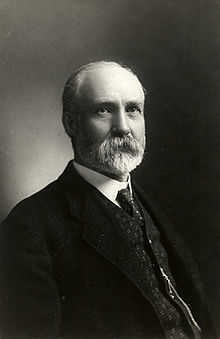
Arthur Philemen Coleman
Build Honor Hut
Through the generosity of Miss Helen Trenholme, of Montreal, a fund was created not long ago for the building of a hut in recognition of Mr. Mitchell’s services to the Alpine Club. To be known as the “Stanley Mitchell Hut,” this has recently been completed in the Little Yoho Valley. The formal opening of this hut was arranged for Good Friday this year when, it was hoped, members and friends would gather to honor Mr. Mitchell and exchange messages with him. Despite his death the ceremony will be carried out as a fitting memorial to him, stated Major W.R. Tweedy, of Vancouver, present secretary of the Alpine Club of Canada, who arrived to take charge of the funeral arrangements. Funeral services will be held at Hayward’s B.C. Funeral Parlors tomorrow afternoon at 3:30 o’clock, followed by cremation at Royal Oak. At Mr. Mitchell’s expressed desire, the ashes will be interred in the Church of England cemetery at Banff, Alta., in June, when it is planned that a number of the executive and other members of the club will be present. Major Tweedy will officially represent the president, C.G. Wates of Edmonton, and other members of the executive at the funeral tomorrow. His only known surviving relatives are two nieces, Miss Dorothy E. Mitchell, now engaged in missionary work at Peiping [Beijing was called Peiping between 1928 and 1949], China, and Miss Barbara A. Mitchell, of London.
Tributes Given
“A good mountain climber and a kindly, courteous gentleman with a very keen sense of humor, he had the gift of creating lasting friendships and was well adapted to meeting and looking after the entertainment of visitors at the Alpine club-house at Banff, where his Summers were spent, and of members attending the club’s annual camps. His many mountaineering friends in England and the United States could never speak too lightly of him,” said the honorary club president, A.O. Wheeler. Major Tweedy also paid high tribute: “A wonderful man, of keen intellect and wide general knowledge, with a tremendous fund of humor which will be greatly missed by all who were privileged to have any association with him.”
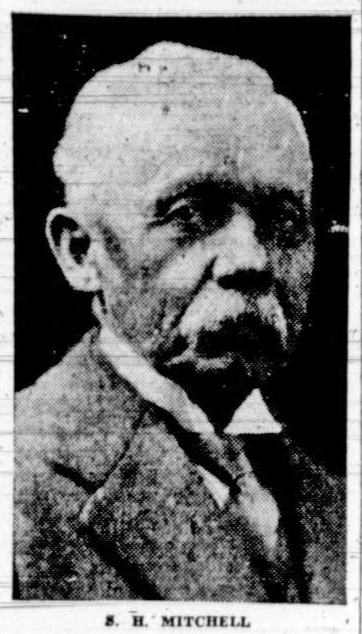
Stanley Hamilton Mitchell
Courtenay Skier Was Champion
Arthur Wood Won Both Downhill and Slalom Events at Port Alberni
Reported in the Comox Argus Thursday March 21, 1940, p.4.
Port Alberni, March 18—Vancouver Island Ski Championship trophies changed hands on Sunday after competitions held in King Solomon Basin near here. Over 70 contestants and spectators took advantage of the wonderful weather to journey to the basin for a most successful day, unmarred by any untoward incidents. During the morning, when the downhill races were held, the snow was crusted—very fast—but softened in the afternoon for the slalom events. The men’s downhill class ‘A’ had the largest entry, 17 plank artists attempting what Eric Laurillard, Vancouver Ski Zone referee stated to be “the toughest downhill course” he’d seen in 14 years of contests. The run was approximately a third of a mile, the first part being steep sidehill with a hard crust. Arthur Wood of Courtenay copped the trophy with the fine time of 35 seconds with Thor Jacobsen, Port Alberni, running very close with 35½. Tom Tysse third with 38¾. In the men’s class ‘A’ slalom, Arthur Wood again sped to victory with times of 15½ and 12. In the Ladies section, Mrs. S. Jacobsen took both downhill (22¾) and slalom (10¾ and 10¾) to gain the double crown of champion downhill and slalom artist for Vancouver Island. Miss Ruth Masters, Courtenay, came second in the downhill, and Miss Mia Schjelderup, last year’s champion, was the runner-up for the slalom. The contests were run by Eric Laurillard, ski zone referee, and Bud Stevens, course setter, both of Vancouver. Laurillard, in addition to his remarks on the downhill course, complimented the entrants, saying that skiing on the Island, has improved 100% since last year. He referred to the King Solomon Basin as a wonderful competition area, difficult to better anywhere.
Banquet Given to Skiers
At the banquet at Good Eats Café supper room, Mayor W.C. Hamilton welcomed the skiers, commenting on the fact of many nationalities competing together in perfect harmony. Later he presented the cups and trophies to the winners and runners-up. Probably the most popular presentation of the evening was to Chris Johnson for “services rendered” to Island skiing. When replying Chris said how delighted he was to see the rapid growth of the sport, and that he would like to see a great many young Canadian skiers. Sid Williams of the Comox District Mountaineering Club thanked and complimented the Arrowsmith Ski Club on the excellent tournament arrangements.
Records and times:
Ladies Novice Downhill
1 L. Gregory 1:06
2 Mrs. D Warren 1:42
Ladies Downhill Class ‘A’
1 Mrs. S. Jacobsen 22¾
2 Ruth Masters 32½
3 Mia Schjelderup 35¾ (7 entries)
Ladies Slalom Class ‘A’
1 Mrs. S. Jacobsen 10¾ and 10¾
2 Mia Schjelderup 14¼ and 14
3 Katherine Capes 17 and 19 (7 entries)
Men’s Novice Downhill
1 Jack Beveridge 29
2 Jack Stelling 29¾
3 P. Legg 31 (6 entries)
Men’s Novice Slalom
1 Fred Smith 12¾ and 13¼
2 Brevik 20 and 14
3 Jack Beveridge 16¾ and 20 (4 entries)
Men’s Downhill Class ‘A’
1 Arthur Wood (Forbidden Plateau) 35
2 Thor Jacobsen (Arrowsmith) 35½
3 Tom Tysse (Arrowsmith) 38¾ (17 entries)
Men’s Slalom Class ‘A’
1 Arthur Wood 15½ and 12
2 Thor Jacobsen 18 and 13
3 Tom Tysse 13½ and 17
Officials
Eric Laurillard Ski zone referee; Bud Stevens, course setter, both of Vancouver.
Alpine Club Camp Draws a Big Crowd
Reported in The Daily Colonist Wednesday March 27, 1940, p.8.
Members and friends of the Vancouver Island section of the Alpine Club of Canada held a successful four-day camp at the Lake of the Seven Hills. During the time, Mount Empress, the highest of the Sooke Hills, was climbed, and a cross country trek was made to Kapoor via Leechtown and returning by Mount Empress. Early on Easter Sunday morning a fire was built on Hill Four near the camp in the hope that the smoke could be seen from Victoria by those attending the sunrise service, but sweeping winds and grey clouds made it impossible. The Alpine Club’s annual dinner will be held on Saturday at the Empress Hotel for members and friends, and those planning to attend are asked to communicate with the secretary, Mr. Fred Maurice, by telephoning G2101 not later than today. A hike is being planned for next Sunday by the club.
Alpine Club Dinner
Reported in The Daily Colonist Sunday March 31, 1940, p.8.
Forty members and friends attended the thirty-fifth annual dinner of the Vancouver Island section of the Alpine Club of Canada, held last evening in the Princess Louise room of the Empress Hotel. After dinner, moving pictures of the Alpine Camp to be held at the head of Glacier Lake, Banff National Park, in the Summer, were shown by Mr. Claude Harrison, president of the Vancouver Island section. Mr. Harrison read an address by Mr. Arthur O. Wheeler, honorary president and founder of the Alpine Club of Canada, dealing with the founding of the club and telling of the camp at Glacier Lake to be held from July 14 to 20. The camp will be situated half way between Lake Louise and Jasper, and can be approached from both directions. Greetings were read from other Alpine Club sections in Calgary, Edmonton and Vancouver. Bowls of erythronium and wild cyclamen carried out the simple but charming table decorations. This was the work of Mrs. Claude Harrison and her committee. Later the guests attended the supper dance in the crystal ballroom.
Mt. Tzouhalem To Be Climbed by Alpine Club
Reported in The Daily Colonist Wednesday April 3, 1940, p.8.
Several members of the Vancouver Island section of the Alpine Club of Canada drove via Sooke Road to Land’s End, from where they climbed Iron Mine Hill on Sunday [March 31]. The pot holes and blow holes in the region were examined with much interest. The next trip will take place on April 14, when Mount Tzouhalem near Duncan, will be climbed. Those wishing to attend are asked to communicate with the secretary, Mr. Fred Maurice, by telephoning G2101, or Mr. Allan Baker, at G7810, not later than Friday, April 12.
Recorded Last Hours Alive
Miners Write Letters Home Telling of Hopeless Fight Against Starvation
Reported in The Daily Colonist Saturday April 6, 1940, p.2.
VANCOUVER April 5—James Ryckman and Lloyd Coombs, who died together at Lonely Vernon Lake on Vancouver Island, after a hopeless fight against starvation, will be buried here next Monday side by side, “the way they would have wished it.” Relatives said the men who suffered together while waiting for the plane which never came to their isolated trappers’ cabin, would not be separated by death. Their bodies were flown here today from Zeballos, the mining community forty miles from Vernon Lake, where they were taken yesterday by airplane. Two letters and another portion of a scribbled diary were found by investigators who made the flight to the lake, adding further details to the tragedy which reached the climax when Ryckman, fifty-four, and Coombs, twenty-four, shot himself.
Letter to Son
Ryckman’s letter was addressed to his son Albert, and Coombs’ to his parents, Mr. and Mrs. J. Coombs. Both men wrote with knowledge of certain death. Ryckman’s letter began: “Well Albert this may be good-bye forever, as I can’t hold out more than another week. We went on half food from November 15 till December 17 and the food was gone. So we have been living on fish, squirrels, martens, eagles, coons and everything we could get. Lloyd’s legs played out about the first of January, so he could not go over to the trapline. All we could do was look after and trap here in the boat.”
Ate Boiled Skins
Ryckman enumerated the catch from the traps and told how they clipped the hair from the skins and then boiled them to eat. He also described catching tiny canaries, which were tempted into the cabin with salt. Bones and feathers from the birds were evident when the belated rescue party arrived. However, Ryckman did not explain how he and his companion ran short of food. They were known to have packed in hundreds of pounds of concentrated provisions when they flew in from Zeballos last Summer. One suggestion advanced by experienced woodsmen was that they cached their supplies around the trapline, but lost them when heavy rains flooded the lake.
Writes Last Note
Ryckman’s letter lay unsealed on a table alongside one written by young Coombs and dated January 31. “This is my last note just in case we don’t get out of here alive,” the youth wrote. “Many a night I couldn’t sleep thinking about home, but these nights I go to bed praying for a plane and for you to hear my voice. . . You are entitled to half the fur. . . God bless you, as I’ve always loved you. . . Your loving son, Lloyd.” Constable N.J. Winegarden, of the Provincial Police, and Coroner Ralph Thistle, who made the flight yesterday with Pilot Jack Hames, of Ginger Coote Airways, found another portion of the diary in which the men kept a record of their last days. It dealt with their first weeks at the lake. Two ragged distress signals fluttered hopelessly near the cabin and inside were found several pails containing the residue from stewed birds and squirrels. Outside the door hung a pint bottle filled with the bones of small creatures which according to the diary had been “saved for a rainy day.” (see full account by Cecil Clark in The Daily Colonist Sunday Magazine section October 8, 1961, p.8-9. and T.W. Patterson in The Daily Colonist Sunday Magazine section June 28, 1970, p.12-13.)
Rope Work Is Practiced on Mt. Tzouhalem
Reported in The Daily Colonist Wednesday April 17, 1940, p.8.
Eighteen members of the Vancouver Island section of the Alpine Club of Canada on Sunday [ April 14] drove to Duncan for the purpose of climbing Mount Tzouhalem. The route taken was up the face of the mountain overlooking the Cowichan Valley. There was some opportunity for rope work and much interest was taken in the Tzouhalem area. The next outing will take the form of a mystery trip, on Sunday, April 28. Those wishing to attend are asked to communicate with the secretary, Mr. Fred Maurice, by telephoning G2101, or Mr. Allan Baker at G7810, by Friday, April 26.
West Coast Skiers Here
Fifteen Members of Port Alberni Club Took Part in Inter-Club Races
Reported in the Comox Argus Thursday April 18, 1940, p.4.
Port Alberni skiers came over to the east coast of the Island on Sunday [April 14] to take part in friendly competition on the shoulder of Mount Becher. The weather was brilliant and the snow fast. The same course was used as last year when the Upper Island championships were held here. Both are stiff. Arthur Wood again won the downhill but was over eager in the slalom. He over-ran a point and lost a ski. Mrs. Jacobsen took both the ladies’ events.
The events were as follows:
Men’s Downhill
1 Arthur Wood, Courtenay
2 Thor Jacobsen, Alberni
Men’s Slalom
1 Robert Gibson, Courtenay
2 Paul Johanson, Alberni
Jr. Men’s Downhill
1 Noel McPhee, Courtenay
2 Norman Wood, Courtenay
Jr. Men’s Slalom
1 Norman Wood, Courtenay
2 Gavin Wood, Courtenay
Ladies Downhill
1 Mrs. S. Jacobsen, Alberni
2 Katherine Capes, Courtenay
Ladies Slalom
1 Mrs. S. Jacobsen, Alberni
2 Mia Schjelderup, Courtenay
Mixed Novice
1 Fred Smith, Courtenay
2 Alymer Boyes, Alberni
After the competitions the party came down to the Lodge, where 35 of them were entertained to a very delightful dinner. Thor Jacobsen presented the cups and Dick Idiens and Cliffe Laver spoke briefly of the pleasure they had in entertaining the Port Alberni Club and in the day’s sport.
Members Climb Mt. Finlayson
Reported in The Daily Colonist Wednesday May 1, 1940, p.7.
Several members of the Vancouver Island section of the Alpine Club of Canada drove to Goldstream Flats on Sunday [April 28] to climb Mount Finlayson. In spite of rain and slippery rocks, the trip was successful and afforded considerable practice in rope work, and the wild flowers and dogwood were at their best. The next trip will be a week-end trek in Mount Trap district. Those wishing to go are asked to communicate with Mr. Fred Maurice, by telephoning G2101 or Mr. Allan Baker at G7810.
Trip Made to Todd Mountain
Reported in The Daily Colonist Wednesday May 22, 1940, p.8.
An unscheduled trip was made by members of the Vancouver Island section of the Alpine Club of Canada over the week-end to Todd Mountain, 3,170 feet, some eight miles from the end of the Silver Mine Road along the Shawnigan-Port Renfrew Trail. One night was spent en route, the summit being reached by noon on the second day. The climbers were rewarded by a superb view of the valleys of Koksilah and San Juan Rivers stretched out in opposite directions, flanked by wooded hills, with a glimpse of the snow-capped peaks of the Cowichan Lake Mountains to the north. Mountain phlox, collinsia and wild strawberries were found in profusion. The trip was followed by dinner at the Shawnigan Lake Hotel.
Plateau is Well Known
Fame of Forbidden Plateau Spread Abroad—Lakes Stocked With Trout
Reported in The Daily Colonist Sunday May 26, 1940, p.34.
Within twenty miles of Courtenay, in the Comox Valley, lies one of the major tourist attractions of Vancouver Island. No visitor can afford to miss the sight of the glorious scenery, the peaks and the chasms and the hundreds of small shrub-lined lakes that dot the surface of the Forbidden Plateau. The trout-stocked lakes and meadows of wild flowers, the strange red snow and the alpine moss lends credence to the legends that have sprung up about this strange plateau. Walled in by a mountain range 5,000 feet high, the Indian legend of the coast tribes tells of a huge and fierce tribe of men that inhabited it at one time. The taboo placed upon the spot by the witch doctors of the tribe kept this centre of Vancouver Island a sanctuary for bird and beast. Today in its 100 square miles there is living not one single human and the mesa is left as it was by the Indians hundreds of years past. To reach this superb plateau there are two ways. One is by way of Dove Creek and the other through Bevan and Mount Becher. To fully appreciate and explore the devious paths and byways of this strange section of country it is advisable to travel either by pack horse or by hiking, and guides are available at the communities along the roads in.
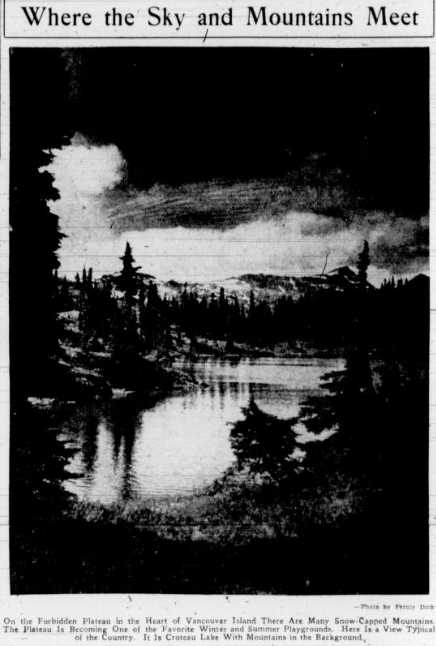
On the Forbidden Plateau in the Heart of Vancouver Island There Are Many Snow-Capped Mountains. The Plateau Is Becoming One of the Favourite Winter and Summer Playgrounds. Here Is a View Typical of the Country. It Is Croteau Lake With Mountains in the Background.
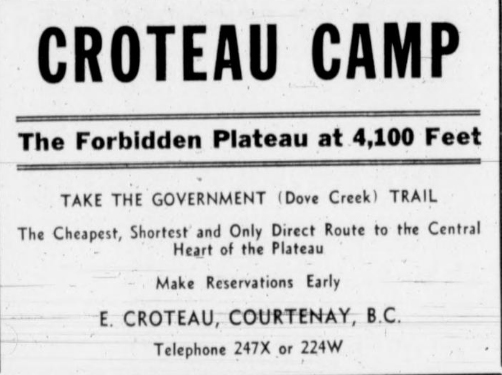
An ad for Croteau Camp.
B.C. Alpinists Atop High Peak
Reported in The Daily Colonist Wednesday May 29, 1940, p.2.
VANCOUVER, May 28—First recorded ascent of 8,000-foot Mount Outram, near Hope, B.C., by a party of six Vancouver and Victoria climbers over the week-end was revealed today. Led by William Mathews, Vancouver member of the Alpine Club of Canada, the party scaled the peak through a rising gale with drifting snow. Members of the party in addition to Mathews included Ernie Jenkins, Fred Parkes, Robert Rolston and David Muir of Vancouver and Miss Elizabeth Thorneycroft of Victoria.
Alpine Club to Hold Week-End Camp on July 1
Reported in The Daily Colonist Wednesday June 26, 1940, p.7.
Several members of the local section of the Alpine Club of Canada went over to Salt Spring Island on Saturday [June 22] afternoon for the purpose of climbing Mount Maxwell on Sunday [June 23]. Camp for the night was pitched at Burgoyne Bay. The route taken was up the face of the mountain. A splendid panoramic view of the surrounding country and mountains was had from the summit. Mount Arrowsmith and Mount Baker being particularly clear. Arrangements are being made for camp at the Lake of the Seven Hills over the Dominion Day week-end. Those wishing to attend should communicate with Messrs. Fred G.P. Maurice, G2101, or Allan Baker, G7810, not later than tomorrow.
At Head of Sproat Lake
Reported in The Daily Colonist Sunday July 21, 1940, p.22.

A Beautiful View of Snow-Capped Mount Klitsa, as Seen From Sproat Lake. Trout Fishing Is at Its Best in the Deep Waters and From the Sandbars of Innumerable Creeks That Empty Into the Bays Along the Shoreline.
Happy Days on Plateau
Conditions Ideal Now for Famous Resort
Reported in the Comox Argus Thursday August 8, 1940, p.5.
If you want to go to the Forbidden Plateau, now is the time; not a cloud over the whole of the Mount Albert Edward range, the trails are drying up and will be in fine shape by the end of the week, the alpine flowers are brilliant and there’s plenty of fish in the lakes. There has been a lot of rain in the high lands this year, far more than there has been down here and the trails over Paradise Meadows above the Forbidden Plateau Lodge have been miry. But with this sun they will be fine this week. Good fishing is reported in all the lakes. The cut-off by the Mount Becher route has greatly shortened the trip into McKenzie Lake and Lake Mariwood. The pull over Mount Becher was always a killer for man and horse and it is a great relief to be able to travel at a good pace, where before you had to plod wearily up foot by weary foot. The Dove Creek trail is just the same. In fact, whilst empires have fallen and the worst gone to pot during the last ten years the Dove Creek trail is just about as it was. It is a cool tunnel on the hottest day. Mr. W. Adrian B. Paul, who is in charge there whilst Mr. Croteau is at Comox, is cutting out some fine trails round Helen McKenzie Lake and has found some giant spruce in his travel, five feet through. That is unusual at four thousand feet. Hey you lads that want to go up to the Plateau but haven’t a tent, there’s one for you at Croteau Camp. There’s a bell tent there for the use of the boys of the district free. Distinguishing visitors to the Croteau Camp are Dr. White and Mr. C.L. Fillmore, magistrate in the Juvenil police court at Vancouver. Mr. Hugh Savage, scoutmaster of the Duncan Boy Scouts Patrol, with three patrol leaders and the A.S.M., have also been camping there.
Shorten Trail to Plateau
Reported in the Comox Argus Thursday August 22, 1940, p.5.
Many visitors to the Forbidden Plateau are finding the way much less wearisome owing to the new trails that have been cut by the government between the Look-out and McKenzie Lake. Last year the man-killing pull over the top of Mount Becher was eliminated. This year the trail from Mount Becher and McKenzie Lake has been straightened and widened. The fishing is excellent in McKenzie Lake, Douglas and Pearse Lakes. A trail has been blazed from McKenzie Lake to Pearse Lake.
Red Snow and Albert Edward
These Are Two Big Attractions of Forbidden Plateau Says Toronto Girl
Reported in the Comox Argus Thursday August 29, 1940, p.8.
An appreciation of the Forbidden Plateau recently appeared in “Onward”, a United Church publication for young people, published in Toronto. It is by Miss G.E. Valentine.
“Mountain-peaks with snow on them all year round are common in the Rockies, but on a small island like Canada’s Vancouver Island, a peaceful pleasure haven for tourists and retired folk, they are a bit of a surprise. And when the snow is not white, but red … We didn’t believe that story about red snow at first, Joan and I. And when we first attempted to reach the Forbidden Plateau, we began to wonder if it was going to be worth the effort. The hundred-mile trip north from Victoria on the Island Highway was beautiful in the extreme, but when we found a twelve-mile walk over a lonely forest trail facing us, a walk that was nearly all uphill and often pretty steep, we lost a good deal of enthusiasm. It was not a bad hike, however, even though we were carrying tent and sleeping-bag on our backs to cut down on expenses; and when we finally came out on the Plateau, the view was well worth a far harder climb than we had had. Directly in front of us was beautiful Croteau Lake, surrounded by dwarf alpine evergreens, and reflecting in its mirror-smooth surface the colours of the rock cliff that rose sheer on its northern shore; in the distance a huge rampart of rock towered up, snow-aced, and impressive as the Rockies. It made us eager to explore.
Fairyland of Flowers
Starting out the next morning, we found ourselves walking through a fairyland of flowers. The Forbidden Plateau country is quite open, grassy meadows alternating with airy wood, and all these open meadows were carpeted with flowers; red and white heather, mauve and yellow and white violets, scarlet Indian brush, and many more. They were at their very best in July; and to people who had never seen the profusion and vividness of alpine flowers it was an unforgettable sight. Everywhere on the Plateau were little valleys and hills, mirror-like lakes, green and still and beautiful. With the flowers, the stunted little trees, and the glorious tangy mountain air it was like a dream world. Following a winding path, we came to a steep slope, clambered up it with several rests and found ourselves on a little elevation called the Dome. The great rock rampart which we had seen the night before had been lost to sight as we walked along the woods and hills of the Plateau; now it suddenly loomed up close to us, a great horseshoe-shaped barrier of rock patched with snow and streaked with innumerable silver ribbons of little waterfalls. Part of the rampart was the mountain known as Mount Albert Edward, its ascent so gradual that even a child can climb it; and we resolved that we, too, would attempt it.
Red Snow at Last
But near at hand were drifts of snow, melting into pools under the hot summer sun, and some of those drifts showed pink, not white. Red snow! Eagerly we hurried over to examine it. Yes, there it was, beyond all doubting; here just a tinge on the dirty white, there a whole drift stained with it. In places it was almost rose, elsewhere faint pink; and it gave one a strange sensation to gaze at it; you sort of wondered if you were seeing straight. We picked up handfuls of the snow to view it closer; and when it melted you could see tiny red particles that gave the snow its color suspended in the water. Extremely small plants, or bacteria, are responsible for red snow although in some places very small insects, called snow fleas, give the same effect. Whatever the cause, it is very rare, however, and there is no other place in the world where red snow can be seen with as little exertion—fifteen not-too-difficult miles from the end of the motor-road with horses available for the entire trip if you want to ride. We tackled the mountain. At first we were afraid of getting lost; then we saw that the way was marked with little piles of rock, called cairns or “rock ducks”, and we followed them without hesitation. None of the way was dangerous; we slithered across snowfields slippery in the hot sun, across bare hot rock; the haunting odour of mountain wallflowers filled the air. The last slope up to the peak was steep and hard work, for it was all loose shale, but we made it at last. And the view amply repaid our exertion. North, west and south was a tumbled chaos of mountains, all rock and snow, of a massiveness and grandeur amazing to find on an island of this size. Beyond them we caught a faint glimpse of the Pacific Ocean, forty miles away. To the east were the great hills of the Plateau; we could not see the coast, nor the narrow strip of the Strait of Georgia which here separates the island from the mainland, but in the eastern distance we could see the mainland mountains rising in endless blue ranges against the horizon sky.
Plenty More to See
It was with regret that we left the peak, after putting our names on the paper kept in a bottle in the cairn that marked the top, and started down. We had seen the two main sights of the Plateau, the red snow and the view from Mount Albert Edward; but there are many others, and one can spend weeks in this mountain wonder and with ever fresh delight. Impressive canyons, beautiful island-studded lakes, ice-caves, there are innumerable attractions for the casual hiker, every kind of climbing for the mountaineer. It’s well worth a visit, the Forbidden Plateau, and it is to be hoped that visiting it is never made too easy. If a motor road were built all the way in, its beauty would be spoiled swiftly by gasoline stations, hot dog stands, high-priced hotels and languid, unappreciated tourists. It is thrilling now to hike in through the cool woods, or ride in with the twice-weekly pack-train that brings supplies—a bit of adventure that few other resorts offer. Why is it known as Forbidden Plateau? Long ago the Indians of Vancouver Island believed that this plateau was inhabited by fierce hairy giants who kidnapped and killed ordinary mortals. They were very much afraid of the area and always gave it a wide berth; not until some ten or fifteen years ago did the white man discover it, and even today no white man lives there all year round. There are two camps open during the summer; but when fall brings the early snows that in a few weeks will be yards deep—not merely inches or feet—everybody bundles up and leaves. Save for a few skiers, the Plateau is left alone in its grandeur all through winter and spring, and not open until the following are the trails reopened and the old legend once more defied.
Receives Post in Air Force
Reported in The Victoria Daily Times Saturday September 7, 1940, p.9.
A Provincial government employee for 11 years, Allan J. Baker, 27, elder son of Mr. and Mrs. George Baker, 2307 Belmont Avenue, has left the city to serve with the RCAF. Mr. Baker left for Toronto this week, where he will go into the survey draughting department. Born in Victoria, Mr. Baker has lived her all his life. He received his education at George Jay School and Victoria High School. He was a member of the Victoria Assembly No. 1. Native Sons of Canada and the Vancouver Islands section of the Alpine Club of Canada. Baker was an enthusiastic hiker and climber. His biggest accomplishment along this line was scaling Mount Baker with a group of local and Vancouver Alpinists last fall.

Allan Baker
Hard Trip to Get Prospector
Police Have Gone in To Buttle Lake
Reported in the Comox Argus Thursday November 14, 1940, p.5.
James Cross, a well-known prospector on Buttles Lake, made a painful trip in a canoe all the way down the mountain lake before he reached the cabin of Dick Rogers at the outlet. He had broken his ankle whilst on his claim. He was exhausted when he reached his destination. Rogers came out to Forbes Landing, where he telephoned to the Campbell River police station for help to get the lamed man out to hospital. Constable McAlpine and the Sutherland brothers have taken in a toboggan to bring the old prospector out over the thirteen miles of trail to the end of the road.
Skiing Has Started
Reported in the Comox Argus Thursday November 14, 1940, p.5.
Even though the average citizen shivered at the sight of the snow at the week-end, the skiers of the district regarded it with delight. Eight or nine ardent ski-enthusiasts went up Mt. Becher on Sunday and found skiing conditions excellent, and are looking forward to a long winter of their favorite sport.
Prospector Is Packed Out
Buttles Lake Veteran Now Safely Home
Reported in the Comox Argus Thursday November 21, 1940, p.5.
Mr. James Cross, 76 years old, for whom a rescue party went into Buttles Lake last week, is now at his home in Victoria recovering after his unpleasant experiences. Cross, who operates a mineral claim at the head of the lake, slipped and broke his ankle when he was 1,100 feet up. He managed to crawl down the mountain to his cabin where he stayed for a couple of days, after which he rowed about sixteen miles to Mr. Dick Roger’s cabin. Mr. Rogers notified the police at Campbell River and Provincial Police Constables Sandy and McAlpine, accompanied by Messrs. W. and J. Sutherland, formed a rescue party. The injured man was packed out on a stretcher, not without some considerable difficulty. The party had expected to have been able to use a toboggan, but there was no snow. Mr. Cross left for Victoria on Saturday.
C.L. Harrison Heads Alpinists
Reported in The Victoria Daily Times Tuesday December 3, 1940, p.11.
Members of the Vancouver Island section of the Alpine Club of Canada, laid aside their hiking and climbing togs and held their annual general meeting and election of officers for the coming year last night at the home of the president, Claude L. Harrison, and Mrs. Harrison, Beach Drive. Mr. Harrison was unanimously re-elected head of the section and Fred Maurice was returned secretary-treasurer. Elected to the executive were William H. Dougan, Francis E. Tuckey, Miss Stephanie Jones and Miss Kathleen “Kit” Houghton. In his annual presidential report Mr. Harrison spoke of the success of the year’s activities, referred to several members who had answered the call to the colors, and hoped the section would carry on as the past. The president spoke of the parent body of the organization and its main clubhouse at Banff. It was one of the world’s most famous clubs. From the Banff headquarters annual camps in the Rockies were held. The parent organization’s Gazette and year book were excellent pieces of work. Mr. Maurice’s financial statement for the year showed a satisfactory balance. Mrs. Harrison, chairman of the entertainment committee, reported three enjoyable parties were held and a number were planned for the near future. The outings committee’s report by Mr. Harrison in the absence of the chairman, Allan J. Baker, who has joined the RCAF, gave a list of week-end climbs and hikes on various parts of the island and visits to the club hut at the Lake of the Seven Hills, Sooke. Highest climb of the year was to the summit of 5,800-foot Mount Arrowsmith near Cameron Lake. Other climbs included Tzouhalem Mountain, Cowichan Bay; Mount Maxwell, Salt Spring Island, which provided good rock climbing to tis 2,00-foot summit from Burgoyne Bay; 2,000-foot Mount Wark in the Highland district when members visited James J. White at Killarney Lake, and several rock-climbing parties on Mount Finlayson. Members also organized skiing parties to Mount Baker and Deer Park, outside of Port Angeles, early in the year. A letter was read from the honorary president of the Alpine Club of Canada, Arthur O. Wheeler, referring to the loss of one of Canada’s famous climbing guides, Christian Hasler, who was known internationally for his work in the Rocky Mountains. Hasler died after many thrilling experiences as guide to climbers and leader of rescue parties.
Officers Named by Alpine Club
Reported in The Daily Colonist Wednesday December 4, 1940, p.4.
Claude L. Harrison was again re-elected chairman of the Vancouver Island section of the Alpine Club of Canada, at the annual general meeting held on Monday [December 2] evening at the home of Mr. and Mrs. Harrison, Beach Drive. Fred Maurice was returned as secretary-treasurer, and William H. Dougan, Francis E. Tuckey, Miss Stephanie Jones and Miss Kathleen Houghton were appointed to the executive. A letter from the honorary president of the Alpine Club of Canada, Arthur O. Wheeler, was read referring to the loss of one of Canada’s famous climbing guides, Christian Hasler, who was internationally known for his work in the Rocky Mountains. This year’s activities were reported in the annual address by Mr. Harrison, who also presented the outing committee’s report in the absence of the chairman, Allan J. Baker, who has joined the R.C.A.F. Climbs and hikes were made to various parts of the Island and to the club’s hut at the Lake of the Seven Hills, Sooke. The highest climb of the year was the summit of Mount Arrowsmith. Skiing parties to Mount Baker and Deer Park, near Port Angeles, were also arranged.
Skiing Good on Mount Becher
Recent Frost and Snow Make it Excellent
Reported in the Comox Argus Thursday December 31, 1940, p.5.
Last night’s frost and the recent fall of snow on the hills has made excellent skiing on Mount Becher. At the Look-out there is more snow now than there was all last year. It is dry powder snow too. Mount Becher is now one of the few accessible places for skiing on the coast of British Columbia as devotees cannot now go over the line to Mount Baker and other U.S.A. resorts. The Forbidden Plateau will be thronged with skiers tonight and through the New Year season.
Lindley Crease
1867 – 1940
Reported in The Canadian Alpine Journal Volume 27, 1939. p.96-98.
By Arthur Wheeler
The late Lindley Crease K.C., was elected to Active membership of the Alpine Club of Canada in 1921, died at his home at Victoria, B.C., on February 16, 1940, after a long illness. His friends of the Alpine Club and there were many, for his bright and happy ways and his lovable disposition made friends of all who knew him, will miss him. Born at New Westminster, B.C., on March 13, 1867, he was the son of Honorable Sir Henry Pering Pellew Crease and Lady Sarah (Lindley) Crease. He was educated at Haileybury Public School, England, and following in the footsteps of his father, a Justice of the Supreme Court of British Columbia, he studied law with the late Mr. Justice Drake of Victoria and was called to the bar of British Columbia in 1890. Later, he founded the law firm of Crease and Crease, barristers of Victoria and was its senior member until his death. As a lawyer he had a wide reputation and was noted for his probity and human kindness. Mr. Crease took an active interest in Church affairs and was Chancellor of the Anglican Diocese of the Province of British Columbia. He was also associated with politics and held the position of President of the Conservative Association of Victoria, B.C. and, at one time, the Vice-President of the Provincial organization. Among other distinctions, he was President of the Vancouver Island Branch of the League of Nations and belonged to the Masonic Order, and to many other clubs and organizations. Mr. Crease was a devoted lover of the mountain wilderness and derived much enjoyment from his attendance at our annual Club camps held at outstanding beauty spots of the Canadian Rockies. He attended many of these, as far back as 1922, and while making only a few minor climbs at them was chiefly interested in obtaining suitable vantage spots to view the great beyond and revel in vistas of towering snow-clad peaks, shinning icefields and tumbling glaciers: to see , far below, the forest-girt valleys enclosing jewel-like lakelets, hidden in their midst, and foam-crested torrents, like ribbons of silver, winding through them; to hear the muffled thunder of the distant waterfall and drink in the ozone of the dizzy heights. How well I remember our Mt. Temple camp in Paradise valley, 1933, and as I write I can see the glow of the great camp fire lighting his happy face, smiling as he listened to the wit and wisdom, the songs and the laughter of the evening programmes to which he was no mean contributor. The Chrome Lake camp, 1934, of the Tonquin valley was his last. He had hoped to attend the Mt. Fryatt camp of 1936 and the Yoho valley reunion camp of 1937, but illness prevented. Chief among Mr. Crease’s joys of the camps was the opportunity they provided for sketching and painting. In this art he was specially gifted and had acquired a large collection of fascinating mountain scenes. I can see him comfortably seated in a sheltered position, high up in the alplands, near the base of a wildly broken rockfall. Above the sun is shining and great masses of white cumulus clouds hang over snowy peaks in the distance; pink heath and white heather mingle with the grassy, flower-strewn slopes interspersed with clumps of umbrella-like spruce trees, giving a glorious representation of Nature’s magic mountain parklands. Close by on an isolated mount reside a colony of marmots, the mountain gopher, popping up and down and standing erect like tent pegs at the mouth of their holes, much interested in the advent of their unusual visitor, who is rapidly including them in a sketch. Among the rocks, close by, the shrill, resounding whistle of the Hoary Marmot, the Whistler, breaks the silence at repeated intervals and the little Chief Hare, the Haymaker, flits from rock to rock and adds its tiny squeak to the eerie fascinations of the surroundings. I should like to see that picture. As an enthusiastic lover of animals, particularly dogs, Mr. Crease was here in his element and was able in off moments of concentration, to study these little denizens of the charming highlands that reach tot eh foot of the great rock peaks. We deeply regret the loss of this member of the Club, whose delights were so much akin to our own and who has with us experienced the exhilaration and exaltation of the mountain heights. We feel that in the supreme heights to which he has passed on he has acquired still greater joys and his memory will long be with us.
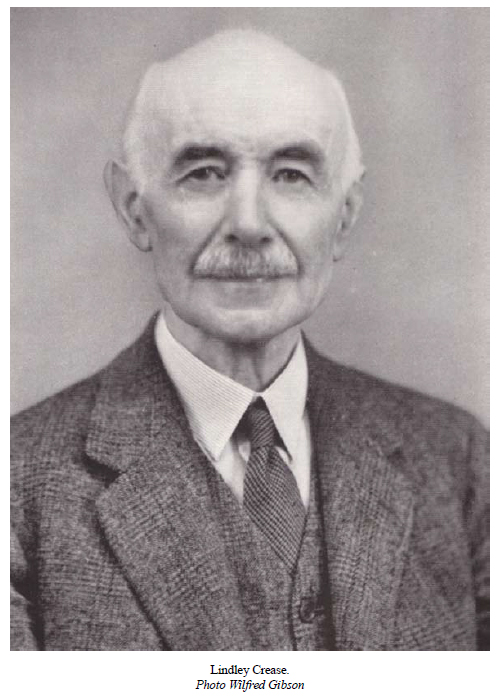
Lindley Crease – Wilfred Gibson photo.
1941
ACCVI executive:
Chairman – Claude Harrison
Secretary/Treasurer – Fred Maurice
Executive Committee – William Dougan, Francis Tuckey, Stephanie Jones, Kathleen Houghton
Events:
February 15/16 – Club trip to Mt. Seymour skiing with Vancouver Club.
February 21/22/23 – Club trip to Mt. Hood.
November 24 – Annual club meeting at Y.M.C.A.
Section members who attended the ACC general summer camp at Glacier July 20 to August 3: Arthur Wheeler, Eleanor “Nora” Piggot, Claude Harrison, Gordon Cameron, Donald Cameron.
Section members who passed away in 1941: Robert McCaw, Fred Leighton.
Skiing on Forbidden Plateau
Reported in The Daily Colonist Wednesday February 18, 1941, p.7.
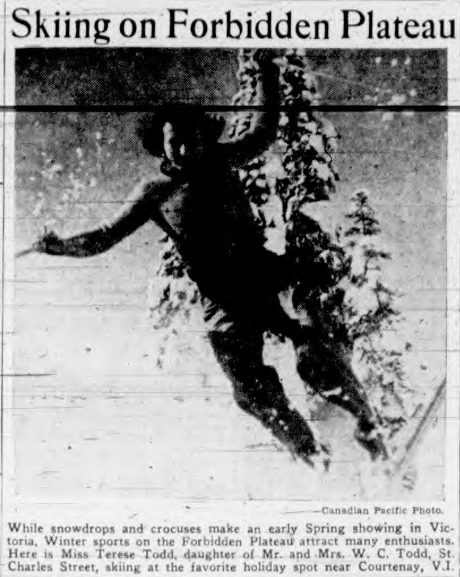
While snowdrops and crocuses make an early Spring showing in Victoria, Winter sports on the Forbidden Plateau attract many enthusiasts. Here is Miss Terese Todd, daughter of Mr. and Mrs. W. C. Todd, St. Charles Street, skiing at the favorite holiday spot near Courtenay, V.I.
Forbidden Plateau by Bus
Reported in The Daily Colonist Friday January 10, 1941, p.8.
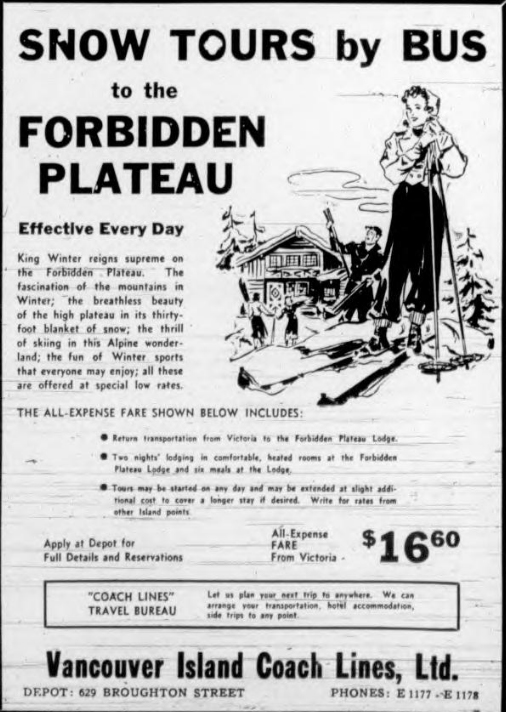
Ad for Snow Tours by Bus to the Forbidden Plateau, Vancouver Island Coach Lines, Ltd.
Skiing Trip
Reported in The Daily Colonist Tuesday February 18, 1941, p.8.
An enjoyable week-end skiing was spent by the Vancouver Island section of the Alpine Club of Canada, when eight members went to the Mainland as guests of the Vancouver section at it cabin on Seymour Ridge. The party was taken up the ridge on Saturday [February 15] night and spent Sunday skiing, returning to Victoria on the midnight boat. The weather was ideal and the views of the surrounding country was magnificent. The next outing will be up Mount Hood on Sunday February 23. Members wishing to join are asked to communicate with the chairman of the outings committee by telephoning G1447 by Thursday.
Ski Tourney on Sunday
Reported in the Comox Argus Thursday March 13, 1941, p.4.
The Upper Island Ski championships are being held on Mount Becher, Forbidden Plateau next Sunday [March 15] commencing at noon. The events are as follows: men’s slalom, novices downhill, ladies downhill, men’s downhill. Following the tournament there will be a banquet at the Lodge at seven o’clock. All entries should be sent to Miss Ruth masters, Courtenay and can be made on the field up to eleven o’clock. Reports from Mount Becher are that the snow is in excellent condition. With no chances of getting to the American side for their skiing, it is anticipated that there will be keen interest this year. Keen competition is expected from Port Alberni. There will be a banquet at 7 o’clock on Sunday night for the presentation of prizes at the Lodge.
Ski-Championships on Mount Becher
Canadian Olympic Star Lifts Cup with Good Local Opposition
Reported in the Comox Argus Thursday March 20, 1941, p.1.
With a member of the 1936 Canadian Olympic team to lift all the championship cups the ski tournament on Mount Becher last Sunday under the auspices of the Comox District Mountaineering Club was a decided success. There were competitors present from the local club, Shawnigan Lake, Victoria and Port Alberni. The star of the day was Karl Baadsvik, a member of the Canadian Olympic team in 1936, when the competitions were held in Germany. The course on the slopes of Mount Becher from the hump near the top to the cabin is very tricky, but he took all the turns with the greatest of ease. He made the men’s open downhill in 71 seconds. Second to him came Arthur Wood, who has learnt his skiing on Mount Becher, with a very creditable 75.4 seconds. The snow was in excellent condition and quite fast. The local club had made efficient arrangements and the whole programme went smoothly. Lindsay Loutet of Duncan acted as starter and Hank Samuelson, now of Port Alberni, formerly a member of the Calgary Ski Club, was starter. The cups were presented at a very pleasant dinner at the Forbidden Plateau Lodge in the evening. Mr. Bert Chandler, president of the local club doing the honors.
Results were as follows:
Men’s Open Slalom
1 Karl Baadsvik, Victoria, 42.3 seconds, 41.3, 84.1
2 Arthur Wood, Courtenay, 49.1, 47.4, 97
3 Norman Wood, Courtenay, 56.2, 55.3, 112
4 Tom Tysse, Port Alberni, 61, 56.1, 117.1
5 Bob Gibson, Courtenay, 67.1, 74.4, 142
Men’s Open Downhill
1 Karl Baadsvik, Victoria, 71.1 seconds
2 Arthur Wood, Courtenay, 75.4
3 Tom Tysse, Port Alberni, 82.2
4 Dick Idiens, Courtenay, 102
5 Leo Maki, Shawnigan, 111.3
Men’s Open Combined
1 Karl Baadsvik, Victoria
2 Arthur Wood, Courtenay
3 Tom Tysse, Port Alberni
Men’s Novices
1 Jack Hough, Cumberland, 40.3 seconds
2 Dave Anstey, Cumberland, 1:07.1
3 A.B. Clement, 1:12.1
4 Bob McPhee, 1:21
Ladies’ Novices
1 Sue Grieg, Courtenay, 1:32.4 seconds
Ladies’ Open Slalom
1 Ruth Masters, Courtenay, 76.2 seconds, 77.4, 153.1
2 Mia Schjelderup, Courtenay, 93.1 sec, 86.4, 180
Ladies’ Open Downhill
1 Betty Brewer, Shawnigan, 3:13.3 seconds
2 Ruth Masters, Courtenay, 3:40.4
3 Mia Schjelderup, Courtenay, 4:54
4 S. Magnuson, Port Alberni, 5:23.3
Ladies’ Open Combined
1 Ruth Masters
2 Mia Schjelderup
Buttle Lake – Plateau Government Park
Reported in the Comox Argus Thursday April 3, 1941, p.2.
There has been much talk of making a government park of the Forbidden Plateau and the Buttles Lake area in the past that one is inclined to dismiss it with a shrug of the shoulders. Yet conditions are different than when it was discussed five or six years ago. The C.P.R. who own the Forbidden Plateau area are now convinced that there is nothing of value in the Plateau area for them and they would be more willing to turn it over to the government than they were. They might be willing to deed it to the province if the government would make it accessible to cars, and until it is, Courtenay’s greatest asset will remain a sealed book to most tourists, who cannot or will not hike. A road would be no job at all if turned over to a logging company on contract, which would be the common-sense way to make it. Then it could be improved as traffic on it warranted. A toll on the road would help to finance the cost. The continuance of the road to Buttles Lake to make the swing round for the tourist is grandiose and would be better left out of the plan until later. So many good ideas have been swamped by taking in too much territory.
Ski Meet on Mt. Becher
Reported in the Comox Argus Thursday April 10, 1941, p.5.
Skiers are beginning to arrive today for the Forbidden Plateau Open Ski Championships to be held tomorrow. The present cup holders of these championships are Miss Gertie Wepsala and Hamish Davidson. The races will start at half past eleven tomorrow. There has been a good local entry. It is reported that the snow on the course is in excellent condition.
Ski Records Are Broken
Excellent Snow Conditions for Tournament At Mount Becher on Good Friday
Reported in the Comox Argus Thursday April 17, 1941, p.1.
The Forbidden Plateau Open Ski Championships were held on Good Friday. The weather and snow conditions were excellent, but there were not many competitors’ records broken at the meet. Norman Wood, Dick Idiens and Noel McPhee all broke the previous records for the downhill race at 71 1/5 seconds set by Karl Baadsvik. Clubs represented were the Forbidden Plateau Ski Club and the Comox District Mountaineering Club. Winners of the cups are: Vancouver Daily Province Cup for men’s downhill and Courtenay-Comox Board of Trade, Norman Wood. Men’s slalom, given by Victoria Times, Len Rossiter. Juniors, presented by Honorable Wells Gray, Jack Hough. Comox Logging Cup for ladies’ slalom and Vancouver Island Coach Lines Cup for ladies’ downhill, Miss Mia Schjelderup.
Men’s Slalom
Len Rossiter (F.P.S.C.) 104 seconds
Bob Gibson (F.P.S.C.) 113
Norman Wood (F.P.S.C.) 119
Noel McPhee (C.D.M.C.) 127
Dick Idiens (C.D.M.C.) 140
Combined, Norman Wood, Noel McPhee, Len Rossiter
Men’s Downhill
Norman Wood 68 seconds
Dick Idiens and Noel McPhee 71
Bob Gibson 82
Len Rossiter 84
Junior Slalom
Jack Hough 199 seconds
- Strachan 328
Gavin Wood (disqualified)
Combined, Jack Hough, S. Strachan
Junior Downhill
Jack Hough 49 seconds
Gavin Wood 54
- Strachan 84
John Fryer 184
Ladies’ Slalom
Mia Schjelderup, 93 seconds
Sue Grieg, 102
Combined, Mia Schjelderup
Ladies’ Downhill
Mia Schjelderup, 226 seconds
Men’s Novice
- Cooper, 58 seconds
A.B. Clement, 61
Bob McPhee, 67
Bill McNaughton, 124
Barnett Harvey Reported Missing
Parents Notified by Minister of National Defence
Reported in the Comox Argus Thursday May 8, 1941, p.1.
The heartfelt sympathy of a host of friends throughout the whole district goes out to Mr. and Mrs. B. Harvey, when it is learned that they have received a cable stating that their only son, Acting Sub-Lieutenant Barnett Harvey, R.C.N. is missing. The following is the message they received on Monday afternoon: “The Minister of National Defence for navy Services deeply regrets to inform you that your son Acting Sub-Lieutenant Barnett Harvey R.C.N. is missing on war service.” It is presumed that the young naval officer is missing from the ship which was sunk by enemy action in the Atlantic recently, and from which it is announced 122 Canadians of three services were lost. [It was thought to be torpedoed about one hundred miles off the Irish Coast.] Popularly known during his school days as “Buster”, Harvey had many friends in this district of Courtenay, who will be shocked to hear this sad news.
Foreign Service Leave
Sub-Lieutenant Harvey left Courtenay Easter week-end to proceed to England, after spending five weeks foreign service leave with his family here. He entered the Royal Canadian Navy as a cadet in August 1938, and has been training in England. He served as Midshipman on H.M.S. Durban from August 1939 to January 1941, and was returning to the Old Country for final courses in training. Sub-Lieutenant Harvey was a native son of this district, having been born at Crystal Springs farm, Comox, on October 19th, 1920. He attended public and high schools in Courtenay and Brentwood Bay College, near Victoria. He has one sister, Miss Pamela Harvey. Mrs. Harvey, mother of the missing lad, has worked unceasingly since before the outbreak of war, for the welfare of men or the army, navy and air-force, and her hundreds of friends as well as civilians, will share the grief which is borne by Mr. and Mrs. Harvey and their daughter at this time.
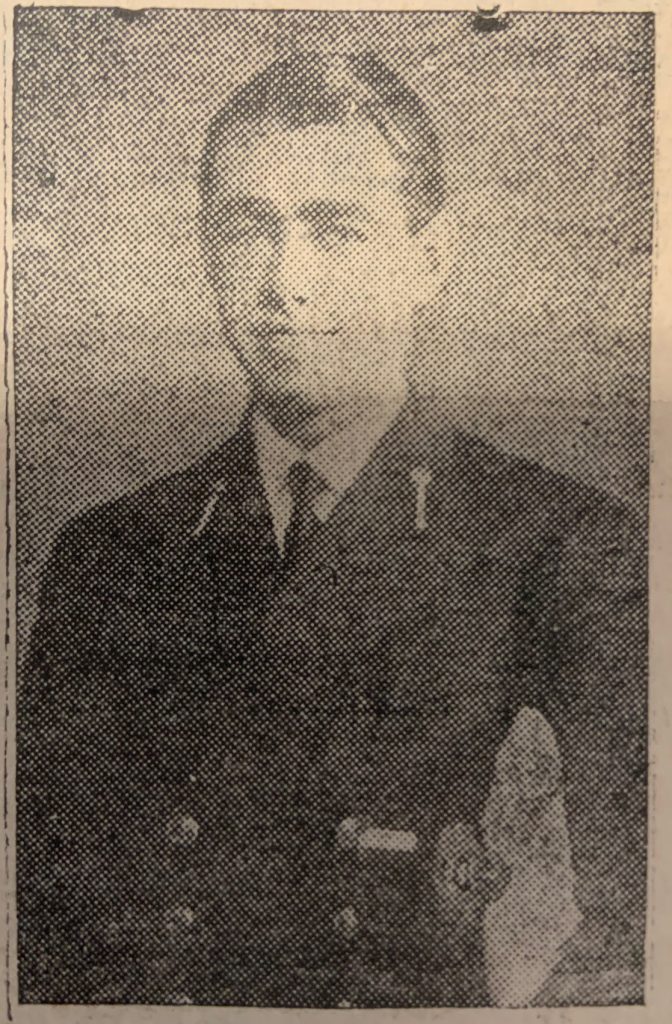
Sub-Lieutenant Barnett “Buster” Harvey.
Postscript:
By Lindsay Elms
Harvey Lake was adopted 11 November 2001 on 92F/12 southwest of Phillips Ridge. Named by Ruth Masters to remember Royal Canadian Navy Sub-Lieutenant Barnett “Buster” Harvey. Born 19 October 1920 in Comox, Harvey had served as a Midshipman aboard a British vessel at Singapore from August 1939 until January 1941, and was rejoining his ship in England after home leave, when his troop transport S.S. Nerissa was torpedoed and sunk during the night of 30 April-1 May 1941, about 100 miles off Ireland in the North Atlantic. When last seen, Harvey was helping people board a lifeboat; of 375 on board that night, only 35 survived. With no known grave, Sub-Lieutenant Harvey’s name is inscribed on the Halifax Memorial.
Croteau Camp
Reported in The Daily Colonist Sunday June 8, 1941, p.18.

Croteau Camp ad.
“There’s Mount Arrowsmith”
Reported in The Daily Colonist Sunday June 15, 1941, p.14.
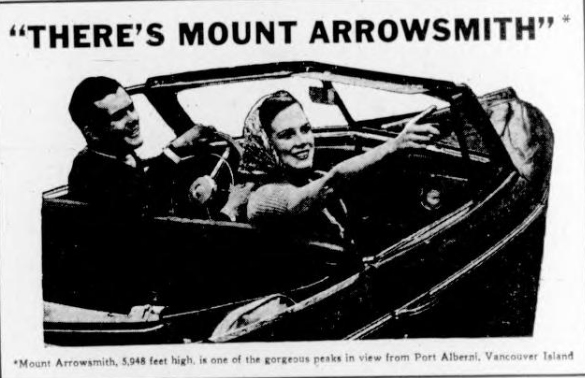
Mount Arrowsmith, 5,948 feet high, is one of the gorgeous peaks in view from Port Alberni, Vancouver Island.
From Ontario
Reported in The Daily Colonist Sunday July 12, 1941, p.6.
Lieutenant-Colonel Horace “Rusty” Westmorland, who will be well remembered by all members of the Alpine Club of Canada, whose camps he frequently attended, is visiting here from London, Ontario, after a long absence. Since being in Victoria, Colonel Westmorland has spent a holiday in Switzerland, during which time he scaled the Matterhorn. Westmorland was a past chairman of the Vancouver Island section of the Alpine Club of Canada.
Attend Alpine Camp
Reported in The Daily Colonist Sunday July 27, 1941, p.6.
Mr. Gordon Cameron and son, Donald, have left today to attend the annual camp of the Alpine Club of Canada at Glacier, B.C.
Telephone Line to Plateau
McKenzie Lake Will Be on Call When Completed
Reported in the Comox Argus Thursday July 31, 1941, p.8.
A new line of telephone is under construction that will provide a circuit from the Forbidden Plateau Lodge on Mount Becher with the camp at McKenzie Lake. Completed this line will be more than six miles long and will be at the highest altitude yet for any telephone line on Vancouver Island. A half a ton of wire will be necessary along with pounds of porcelain insulators.
Modern Plateau Camp
Reported in The Daily Colonist Sunday August 3, 1941, p.12.
The Forbidden Plateau continues year after year to attract visitors bent on seeing the “mystic plains” of Indian legend. It is no simple task, owing to the lack of roads, but Croteau Camp, situated in the heart of the plateau, brings their guests in by pack train. Living in a modern camp of cedar cabins right in the midst of the grounds to be explored has proved to be the most popular method of seeing this grand place. The Forbidden Plateau is reached from Courtenay, on the Up-Island Highway.
American Explorer First to Reach Top of Alaska Mountain
Bradford Washburn Completes Daring Climb of Mount Hayes, Accompanied by His Wife and Party—Writes of His Experiences
Reported in The Daily Colonist Sunday August 10, 1941, p.2.
By Bradford Washburn
FAIRBANKS, Alaska, August 9—Completing a carefully planned three weeks’ mountain-climbing blitzkrieg, our small party of seven reached the base camp at the head of Delta Creek, Wednesday, after the first successful ascent of Mt. Hayes, 13,740 feet, the highest virgin peak in the Alaskan interior. Five members of the party reached the summit just after noon on August 1 after a seven-hour climb from a camp in the 9,500-foot notch in the crest of the magnificent northern ridge. The temperature on top was 12 degrees, with a gale from the northwest, while in Fairbanks the temperature at the same moment was 69 degrees.
In Sea of Clouds
At the summit a solid sea of great stormy clouds rolled past us to the north, with a surface of 12,000 feet and the peak rising from it like an icy island in a fog. To the south and the east there was a superb view over huge glaciers and a wilderness of jabbed peaks and ridges. Members of the party were Henry S. Hall, Jr., of Cambridge, Mass., who planned the expedition with me; Sterling Hendricks, of Washington, D.C.; Benjamin Ferris, of New York; William Shand, of Los Angeles: Lieutenant Robin Montgomery, United States Army; Mrs. Barbara Washburn, and myself. We left Fairbanks of July 15 by airplane and landed in a small field of gravel at the head of Delta Creek, twelve miles from the base of Mount Hayes. The size of the field necessitated three flights to land all the party and we walked thence to the base of the mountain, where 600 pounds of equipment and food were parachuted to the camp from the plane, and another 700 pounds, carefully packed in bundles, were dropped out to us with no parachute. Practically nothing was damaged except a box of crackers and a sack of prunes, which exploded like bombs when they hit large rocks.
Scouting Route
The base camp was established on July 20 at the 5,000-foot level and three days later Hall, Hendricks, Mrs. Washburn and myself occupied a camp at 8,300 feet and started scouting out the route ahead. A storm slowed up the advance, but by July 26 all of us were living in a camp at 8,000 feet pitched in a sheltered hollow between huge snowdrifts. Another storm on July 27 brought a two-foot snowfall. We broke a trail up the ridge through knee-deep snow and drifts, often over waist deep, to carry eight days’ supply of food and gasoline to a deep cleft in the ridge at 9,500 feet. There camp was set up for the final assault on the summit, 4,000 feet above. After reconnaissance on July 29 we were thrown back by a storm at 13,000 feet and descended for more food and fuel. Two tents were pitched in holes dug in the snow in a notch with an ice grotto excavated between them for storage of supplies. The temperature in this camp was only once above freezing and was usually about 20.
Atop Mount Hayes
On August 1 all of the party reached the top of Mount Hayes in a twelve-hour climb except Hall, who remained at the high camp, and Lieutenant Montgomery, who had returned to Fairbanks four days before for army duty. We reached the high camp on our return at 6:30 p.m. August 1 and returned to base camp on August 2 and descended thence to the landing field, where we radioed to Fairbanks for a plane with a small portable transmitter. Ferris Shand and Hendricks are remaining in the mountains ten days longer for further exploration. Hall, Mrs. Washburn and I plan real photographic flights over the same region on the first clear day before returning East. It is believed Mrs. Washburn is the first woman to make the ascent of Mt. Hayes. We carried a small silk flag of the National Geographic Society to the summit in a tiny aluminum cylinder. The first attempt to climb Mt. Hayes was made in 1935; the names of the members of the party are not known, but they were local Alaskans. They reached 9,000 feet on the great eastern ridge before abandoning the climb. On July 13, 1936, I made the first flight around Mt. Hayes with Pilot S.E. Robbins of Pan-American Airways on an exploration for the National Geographic Society and obtained aerial pictures from which every detail of this year’s carefully planned attack was worked out.
Forbidden Region of Indian Legend Now Tourist Spot
Opening of Roads to and Resorts Within the Haunted Region of Vancouver Island Gives Vacationers as Many Thrills as Natives Received, Although of a Different Character
Reported in The Daily Colonist Sunday August 10, 1941, p.16.
One of the newest, and one of the most stirring sights of many breath-taking grandeurs of Vancouver Island is the Forbidden Plateau, about half way Up-Island on the Eastern Coast. Some 5,000 feet above sea level and walled in by mountain ranges, this beauty spot has more native historic interest than most parts, besides its own charm of clear air and beautiful scenery. This was a haunted region, in the estimation of the Indians of Vancouver Island and nearby mainland coast. Only medicine men, tried and strong in the ways of magic, could hope to enter the area by the very few accessible routes and return unscathed. And high, in the estimations of the Indians, was he who had made this journey and returned to his tribe. His charms bore the greater power through his test, his word became a firmer law, and his predictions held higher authority. Even the present visitor to this region feels just a trifle superior to the ordinary vacationer, upon his return to “civilization.” For despite having every modern comfort at hand in the resorts catering to plateau sightseers, there is a feeling that enters the breast with the first hundred steps of being farther from the haunts of man than seaside or lake resorts can give.
Newer Resort Area
Only a few years ago was the possibility of this being an ideal playground recognized and the first camp established. From a humble start the fame of the region has spread with amazing rapidity, and it is now known far and wide as one of the premier tourist attractions of the Pacific Coast. Literally hundreds of lovely lakes lie amidst the ranges of hills of the Plateau, several of particular charm. Vast tracts of the region are unencumbered by undergrowth, which makes for far greater hiking pleasure than tangled woodlands usually supply. Red and white heather clings to every arable fissure of the rocks and spreads a soft canopy on meadows. Many summits and peaks are still unconquered by climbers, which is an incentive to hiking expeditions, and the absence of undergrowth makes horseback riding a far more attractive pastime than usual in mountain regions. Fish abound in the streams and lakes, where clear, cool depths of water bring the fighting trout to the acme of size and table quality.
Starting Point
Rail and road both serve the vacationer to within a few miles of the Forbidden Plateau. Courtenay, near Comox Harbor, is the starting point for all traffic entering the mystic region, this town being a railway terminus of the line from Victoria, and also being the Up-Island Highway, 140 miles by motor from the capital. Comox Harbor offers all the advantages of salt water holiday joys as an added attraction to inland exploration, there being bathing beaches on both sides of the harbor, sheltered areas for boating, or wide, windswept waters for yachting and motor-boating. Many excellent motor camps and hostelries on the seafront in Courtenay, at the edge of the Plateau or right in the centre of the Indian magic lands, make accommodation a minor problem for visitors.
Fresh Wonders on Plateau
Reported in the Comox Argus Thursday September 4, 1941, p.3.
By Ben Hughes – editor of the Comox Argus
To one who has been paying brief visits to the Forbidden Plateau for the past 14 years there is always something fresh and new to be found on tits trails. Life does not awaken on the Plateau until the end of June and twilight sleep has descended upon alpine meadows by the end of August. This year the Plateau in the last week of August was alive with wasps—millions of them. Stand under a conifer and there came a hum like a hive. Few could be seen flying. All were intent on something hidden away in the somber foliage. Wasps are no storers of nectar for the coming race; what were they doing in their millions just before the white hand of winter stills all life; what food would they be gathering in the age-old dwarf trees of the Plateau? I’ve never seen so many “whiskey-jacks”, those lovable rascals of the camp. These birds, so bold in the solitude of the hills, yet so averse to all contact with normal human activity were flitting on muted wings from many trees on the trails. Gradually the logger is creeping closer and closer to the Plateau. Up the Cruikshank Canyon, up the slopes of Mount Washington, the trees are falling beneath the axe. The Plateau should remain unscarred. C.P.R. cruisers have been all over it and prospectors have found no minerals. So, it should be safe from exploitation for there is nothing worth cutting or digging. It may long remain a haven of rest for souls, tired of the rush and banality of life below in the valley. It is becoming easier to reach. McKenzie Lake is now connected with the outside world by telephone thanks to the enterprise of the management of the Forbidden Plateau Lodge and the ingenuity and enthusiasm of Teddy Robson. A car has climbed to within a short distance of Breakneck Hill on the slope of Mount Becher and the new trail to McKenzie Lake cuts out the hard climb up and down the pass of that mountain. The Forbidden Plateau Lodge has had many visitors this year, including many notables and has extended its facilities for taking care of them. Mrs. Mary Wood, its hostess, is always ready to receive weary guests coming in from McKenzie and Mariwood camps and to provide them with hot baths, dry clothes and wonderful home-cooked food at amazingly short notice. A Croteau’s Camp, Mr. W. Adrian B. Paul is a most informing guide. His Plateau is equaled by only one other knowledge of the topography of the man and he is always scouting for new wonders. There are many delightful meadows and lakes on the Forbidden Plateau, known only to surveyors and trappers; trails will open them to the tourist and Mr. Paul will be the guide. One of the most exciting items of fare round the table at Croteau Camp is Croteau’s whole wheat bread. The wheat is grown on the farm of Mr. Eugene Croteau at Comox, is ground at the Comox Creamery and is made into bread at Croteau’s Camp by Mr. Paul. It certainly goes well with blueberry pie and Comox butter.
Logging and Buttles Lake
Protest at Proposal that the Mountain Should Be Exploited
Reported in the Comox Argus Thursday September 4, 1941, p.4.
According to the Honorable Wells Gray, Minister of Lands, a special report will be made by Forestry officials on logging at Buttle Lake. Most of the timber around the lake was reserved for the crown during the life of the Tolmie government, but some of it at the end, where the trail comes into the lake, was not. Preliminary lines have been run in this and admirers of the beauty of Buttle Lake, are up in arms about it. The Vancouver Sun has protested in an editorial and the Victoria Times ran the following comment:
“Irving Brant, a special writer in the Times, said that loggers are now starting work near the north end of the lake and that if the timber is removed it will ruin one of the Island’s great outdoor playgrounds. Most of Buttle Lake is in the Strathcona Park reserve, but a few miles at the north end is not included and is alienated land. Mr. Gray said that while he knew there was logging going on in the region, he was not aware it was near the lake itself. He is instructing his forestry staff to investigate. The suggestion has been made that the government might arrange an exchange of timber with holders of the logging rights at the lake, so that the virgin forest could be preserved. Mr. Gray said he understood most of the timber near the lake was coverage and that logging operations were some distance away. The boundary of Strathcona Park cuts across Buttle Lake, as if the park had been laid out by simply drawing a line on a map without regard to the contour of the country. The north end of the lake, just outside the park, is the most popular holiday resort.”
Island Section of Alpine Club Elects Officers
Reported in The Daily Colonist Sunday December 3, 1941, p.18.
Claude L. Harrison was re-elected chairman of the Vancouver Island section of the Alpine Club of Canada on Monday [November 24] at the annual meeting in the Y.M.C.A. The executive will be secretary, Fred Maurice; executive William H. Dougan, Miss Elaine Beeston, Mrs. C.L. Harrison and Francis E. Tuckey. Mr. Harrison in his annual report, made special reference to the annual camp of the parent society which he attended at Glacier as the representation of the Vancouver Island section. The members present stood in silent tribute to the memory of Fred Leighton, a late member killed recently while on service with the R.C.A.F. overseas.
To Forbidden Plateau
Reported in The Daily Colonist Tuesday December 30, 1941, p.6.
A party of Victorians will leave today to spend the New Year’s holidays skiing at the Forbidden Plateau. In the group will be Mr. and Mrs. Allan Baker, Miss Dorothy Newman, Miss Wynne Shaw, Miss Margaret Vantreight, Sub-Lieutenant Frank Stevens, R.C.N.V.R. and Mr. Harry Bleasdale.
Sergeant-Pilot Robert F. Leighton, R.C.A.F.
1916 – 1941
Reported in The Canadian Alpine Journal Volume 28-No. 1, 1941. p.117.
By Fred Maurice
Sergeant-Pilot Robert Frederick (Fred) Leighton was killed November 1, 1941 while serving overseas with the Royal Canadian Air Force. Born in Brandon, Manitoba, on July 1, 1916, he was educated in Victoria and was well-known in sports, and Boy Scout circles. Prior to his enlistment in the R.C.A.F. he was employed in the Geographical Branch of the British Columbia Department of Lands in Victoria where he was extremely popular with his fellow employees and was held in high regard. Joining the Alpine Club of Canada as a subscribing member in February 1939, he immediately became an ardent enthusiast and determined to graduate at the first opportunity. The opportunity arose in September, 1939 when, on the week-end of the outbreak of the present hostilities, Mr. Eric Books led a combined party of Vancouver and Victoria members on Mount Baker for the purpose of graduating those members who wished to attain active membership but had been unable to attend camp. It is interesting to note that the other two men from Victoria [Allan Baker was one] who took part in that climb are also now serving their country with the Royal Canadian Air Force. Fred spoke most enthusiastically of Mount Baker and had hopes of many more climbs after the war. In the activities of the Vancouver Island section he was one of the hardest and most enthusiastic workers, and was most popular with all who knew him. He entered into his work and studies in the Air Force with the same energy and enthusiasm that characterized all that he did and he made rapid progress. Leaving Victoria in September, 1940, he won his wings in Calgary in March 1941 and went overseas in May. He was stationed with the Canadian Bomber squadron of the Coastal Command in the north of Scotland. The sympathy of all goes out to his parents, Mr. and Mrs. P.R. Leighton, of Duncan, B.C.
1942
ACCVI executive:
Chairman – Claude Harrison
Secretary/Treasurer – Fred Maurice
Executive Committee – William Dougan, Francis Tuckey, Elaine Beeston, Mrs. C. Harrison
Events:
March 28 – Meeting where through a vote the ACCVI section was disbanded.
Section members who attended the ACC general summer camp at Consolation Lake: Muriel Aylard, Dorothea Hay.
Section members who passed away in 1942: William Everall.
Memo Re-Vancouver Island Section Disbandment
Compiled by Fred Maurice
I joined the Alpine Club of Canada in 1934. I joined at the suggestion of Mr. Claude L. Harrison, whom I had met only through going occasionally to his office for advice in connection with one or two trips into the hills of Vancouver Island which I made on my own. Of the Alpine Club of Canada, I knew nothing, but Mr. Harrison had given me some very good advice in the past, and I had learned to rely on his judgment. Consequently, when he told me that the Alpine Club of Canada was worthy of support even if I made no use of my membership, I accepted the statement at his face value and joined. Immediately after joining it became clear to me that a group of members, of whom not all were subscribing, had no use for the parent body. I formed the impression that it was regarded as an organization that bled as much money from its members as possible and gave back in return as little as possible. The publicity given to its camps was anything but favorable. I also noticed that the majority of active members took no part in section activities. On one occasion I was told by an Active member words, which if my memory is correct, were as follows “any fat old lady can become an active member if she has enough money to pay enough guides to pull her up a mountain” – I may be wrong in this, but that is my memory. During the months of July 1935, Mr. Harrison asked me if I could get enough time off to go to the Assiniboine camp – get my active membership, and see the Alpine Club of Canada for myself. I gasped for a moment and then realized at what he was aiming. I managed to squeeze myself a week off in the middle of my busiest time of year – but I hadn’t the necessary equipment – that didn’t matter because Mr. Harrison had, and was more than willing to lend whatever I needed. The memories of my three days at the Assiniboine camp are amongst the most pleasant of my life. My “instructions” from Mr. Harrison on my return were brief and something like this – “You’ve you have seen it, you’ve enjoyed it all now – talk about it, and try to overcome the attitude which exists.” One other member of the Section attended the Assiniboine camp and came back with the same reactions. We may have overdone the talking – but each thereafter until and including 1938 a fairly good presentation went from this Section to Camp, and the other element appeared to be dying out. Then came 1929 – many were unable to attend camp, by early 1940 a number of members were on Active Service, and the old troubles began to creep in again. This time, of course, nothing was said directly to me – but there was an obviously strained atmosphere. There were several new members whom we felt were getting the same propaganda talked to them as had been talked to me in 1934 and 1935. It was becoming difficult to arrange outings – many members were away, and again a group of the members were keeping away from Section activities. No reasons were given, but they just did not show up. This was much the same situation as had been noticed in 1934 and 1935. Sometime about 1936 there had been a number of people brought out as guests on Section outings. They had been regarded as prospective members, and, as such had been encouraged, and shown a good deal of hospitality. The majority of these did not join but appeared still anxious to come on Section outings. Therefore, in fairness to members, a rule was passed that no person should come as a guest on more than two outings in any year. This overcame the difficulties for a time. In 1940 a new group of prospective members was brought forward under much the same auspices. It may have been entirely coincidence that this group was brought forward at a time when a fairly large number of the members of the Section were either away on Active Service or spending their spare moments studying for war service. It may also be correct that some people can afford to take a trip to two or three week-ends of every month, and in addition pay Section dues, but be absolutely unable to produce another five dollars a year to the parent body. It may also be correct that a Section which refuses to take these people in as Associate members is not performing a proper duty to the Alpine Club of Canada. On returning from Military camp at the end of September 1940, I was told that one of the members of the Section was taking out private outings made up partly of Section members and partly of non-members. This suggestion was that he either had formed, or was about to form, a separate Club. About a month later this member called me up one evening and asked if he could come around and see me. Upon arrival he said that matters had come to a point when he felt we should have a definite understanding and he would like to talk things over. I told him I would only discuss it in the presence of the Section Chairman, to which, after some protest he agreed. Accordingly, I telephoned Mr. Harrison and at his suggestion, the two of us went round to his house. On the way round, this member told me of the group he had gathered together, about 20 in number, who had no interest in mountaineering, and “like myself, do not want to dangle on ropes”, but do want to hike and enjoy the out of doors. He proposed that the Section should take in these people as Associate members – the Section would benefit by their dues, and if it did not agree to take them in, it would – (and again I quote) “wreck the Section.” Upon arrival at Mr. Harrison’s house the same ground was gone over/Mr. Harrison’s reply was that personally, he would never agree to such a course as taking in an unlimited or unsubstantial number of members who had no interest in mountaineering, and expressed it as his opinion that, if persons could join the Section without joining the Alpine Club of Canada, then the Alpine Club of Canada could never expect any new members from Victoria. He also expressed it as his opinion that any member who desired to form a new Club was quite at liberty to do so, but, that he Mr. Harrison, considered that in such a case the member should resign from the Section and in the interests of good sportsmanship, should not canvas Section members to join the new organization. He also stated that he could not look with much favor upon an organization which was formed by a member of the Section, without knowledge of the Executive, and was then held up to them with the remark that you can accept it as part of the Section or it will wreck the Section. The reply to all this by the member who had formed the new organization was to the effect that he had canvassed Section members, that he intended to continue to do so, that his group were willing to join the Section, at Section dues only, that their money would be useful to the Section, and that their alternative to accepting them was a break-up of the Section. Mr. Harrison re-iterated his views and asked that the member reconsider his plans. No more was said on the subject and it was hoped that the matter was dropped. The Annual Meeting of December 1940 passed without incident. The meeting was held at the Chairman’s house. He had for several years past offered his house for the Annual and other meetings to save the Section the expense of renting accommodation. A short time afterwards a new member of the Section who came to my house one evening, criticized the procedure of holding meetings in private houses, criticized the procedure which was followed in the Section of the retiring Executive suggesting a slate for the coming year, particularly criticized the fact that the same Chairman had held office for a number of years, and made several personal criticisms of the Chairman himself. This was purely private conversation, but was said with a tone of some bitterness and I felt that it was probably being said to other others beside myself. (In connection with the above remarks I would mention here that shortly before the Annual Meeting of December 1939, Mr. Harrison had invited all members to an informal meeting at his home, at which time he asked to be relieved of the job of Chairman, and suggested a very old-time member as a successor. The proposed successor refused to accept the nomination. And the members present unanimously asked Mr. Harrison to carry on.) The 1941 outings season commenced in February. The first outing scheduled was one of the hills off the Malahat Drive and was to be followed by a dinner at a restaurant on the highway. When the time drew near a number complained of the price of the dinner (60 or 65 cents) and wanted something arrange to cost about 35 cents. A number of guests wanted to come along and many of them could not afford more than 35 cents for a dinner. Later, in accordance with rules, a list was turned in of proposed guests. All had been out on Section outings at least twice in the previous twelve months. The answer given to objections was that this was a new year and that anyone was entitled to come out twice in this year. The final outcome was that the Section outing was carried out, and the other group (actually consisting of the organization referred to previously) under the leadership of the Section member who had organized this group and consisting also of certain additional Section members, started from the same point and climbed the adjoining hill. Considerable ill-feeling was caused by this incident. The Chairman then called a meeting to ascertain the feeling of the members towards the situation. He outlined the whole situation and said that he felt any member who organized a body in what appeared to him to be opposition to the Section should resign from the Section. The member in question took virtually no part in the lengthy conversations which only tended to make the ill-feeling more intense. Shortly after this, the Executive decided to suspend all activities. It was by this time fairly obvious that the two groups could never get together and settle their differences – there was far too much bitterness for such a solution. The natural thought was that matters would drift until the next Annual Meeting and that whichever group was defeated would resign. The Annual Meeting took place in December 1941. A contest took place for Chairman and Mr. Harrison was returned by a substantial majority of both Active and Subscribing members. Over three months went by and the only development was that several members of the defeated group paid in dues for 1942. Then with the Club anniversary approaching, one or two members asked what plans, if any, were being made for a dinner. This brought matters to a head, and at the call of the Executive, a meeting was held on March 28, 1942, to discuss the future of the Section. The result of the meeting is now known.
In a letter to Herbert Sampson [past president of ACC] from Arthur Wheeler regarding the future of the ACCVI and problems they were having within the section he wrote:
“For more than a year there has been trouble in the Vancouver Island Section of the Club, which has been altogether detrimental to its effectiveness. We decided to take radical action and clear it up, so called a general meeting for Saturday, March 28, 1942. We met and, after discussion, a resolution to disband was voted upon with a majority of 20 to 5 in favour of such action. The Vancouver Island Section then ceased to exist. The same evening a number of the old members drove out to Sidney and held a meeting at our house. It was decided to form a provisional section, to be named “Victoria Section of the Alpine Club of Canada”. All present, some twelve in number, signed an undertaking to join as members of a provisional section. By unanimous vote I was appointed provisional chairman and Mr. Fred W. Maurice provisional secretary. The formation of a newly named section is, of course, subject to the approval and consent of the club. Will you please secure this for us at the earliest possible date, so that we may continue full organization of a Victoria Section….. I may add that the two principal causes of trouble were: A certain number objected to paying the Alpine Club of Canada dues of $5.00 in addition to Section dues of $2.00, but desired to continue with the Section and participate in the name and prestige of the Club. Others did not want to climb, but wanted a purely hiking concern, and so on to make trouble.”
Yours most truly,
Arthur O. Wheeler
Chairman provisional Victoria Section
Eric Brooks, the president of the club, didn’t know how to deal with this and was reluctant to recognize the new section. Many letters went back and forth but it is unclear how the difficulty was resolved and it wasn’t until 1946 that an active Vancouver Island Section reappears.
Our First Years
Reported in the 50th Anniversary, Outdoor Club of Victoria, 1942 – 1992.
By Ruth Clay
The Outdoor Club began as a breakaway group of the Victoria section of the Alpine Club of Canada. People hiked with the Alpine Club in the 1930’s and did some technical climbing but the breakaway group wanted more local hiking and on a regular basis. Alternate Sundays were chosen and the system worked very well. So well, in fact, that a meeting was called by Thomas Goodlake for March 7, 1942, and the Outdoor Club was officially born. The first meeting of the Club began with a mere telephone list and the eight people who were present at the meeting were Shirley Bastin, (at whose house they met), Katherine Capes, George and Thomas Goodlake, Ruth Griffith, Hope Hodges, Gordon Turner and Joan (Hall) Williams. The object of the Club was, “The Club is for people interested in the outdoors for hiking and for other side interests such as nature studies and biking parties. During the war years many members joined the forces and left town. Those dedicated members who kept the Club operational were Thomas Goodlake, Stephanie (Bowes) Manson, Bill Mathews and Elizabeth Thorneycroft. They and others kept in touch with the far-flung members, sending out copies of the “Groundsheet”. Transportation was a problem, during those years, so trips were planned by bus service and with the use of Thomas Goodlake’s 4-seater yellow convertible “The Banana”. On occasion it was proved this vehicle could carry more than ten people. Gas rationing did not help this situation. Using buses meant that many mountains were climbed in the area surrounding Victoria. Interesting points from those early years were:
The Groundsheet was mailed for one cent per copy.
Good boots cost up to $10.
Monthly meetings were held in private homes.
Up to 1946, a long weekend was considered two days.
The photo album was started in 1944.
In July 1946 there were 57 members recorded.
Forbidden Plateau by Bus
Reported in The Daily Colonist Thursday January 22, 1942, p.6.
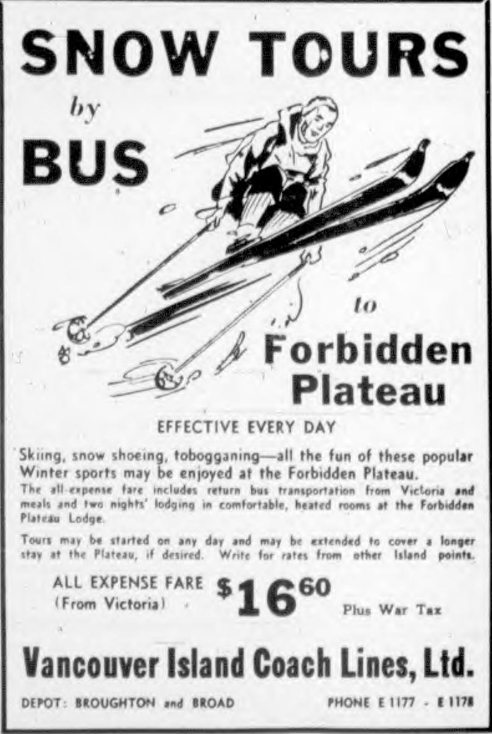
Ad for Snow Tours by Bus to Forbidden Plateau, Vancouver Island Coach Lines Ltd.
Skier Brought Out by Tobaggan
Reported in the Comox Argus Thursday February 5, 1942, p.5.
Much fresh snow has fell during the week-end on the Beaufort Range behind Courtenay. There is now snow at the Forbidden Plateau Lodge and it is possible to ski all the way down from Mount Becher cabin. It is a powder snow and with the first touch of harder weather will be ideal for skiing. The few devotees who went up at the week-end saw an artist at work. Karl Baadsvik of Victoria, who has been on an Olympic team came to try the slopes of Mount Becher with his wife and small son. It was a picture to see him going down the twisty road from the Lodge with his son on his shoulders as well as watch his mastery of the blades on top. Three veterans of the trail stayed in the cabin over the week-end, Captain George H. Ash, Mr. Bert Chandler and Miss Peggy Sillence. On Monday came down word that Captain Ash had fallen and twisted his knee and would have to be brought out on a toboggan. A small party consisting of Roger Hughes, Bobbie McPhee, Mia Schjelderup and A. McMonies packed up their skis just after noon and took the trail. The trail has not been packed and they expected a very heavy and difficult journey out.
Comox Flyer Is Missing
Reported in the Comox Argus Thursday March 5, 1942. p.1.
Mr. and Mrs. Maurice G. Fairburn of Comox have received a telegram from the Air Council dated February 24th that their eldest son, Pilot Officer Douglas Fairburn was reported missing. The sympathy of friends and acquaintances throughout the whole district will go out to Mr. and Mrs. Fairburn and to Mrs. Douglas Fairburn, his wife, in their anxiety and all are hoping that good news will be received. The wire read “Regret to inform you that your son Pilot Officer Douglas Fairburn, is reported missing as a result of air operations on February 24th. Any further information received will be communicated to you immediately. Should news reach you from any source please inform me. The Air Council express their sympathy with you in your anxiety. (Signed) The Air Officer in Chief RCAF Officer. Pilot Officer Fairburn, RCAF, graduated as a Sgt.-Observer last fall, and he was granted a commission as Pilot Officer, before proceeding overseas. On October 30th he was married to Miss Margot Bate of Nanaimo, and his wife accompanied him to eastern Canada. She is now resident with her parents in Nanaimo. Pilot Officer Fairburn was on staff of Comox and Bevan Schools prior to joining the air force. He was born in Courtenay and having lived here and in Comox all his life, he was one of the most popular young men to leave the district to join the armed forces. He was an outstanding athlete, and a prominent member of teachers’ organizations, Kinsmen and other clubs in the district. Mrs. Fairburn has received a letter from Pilot Officer Fairburn since the cable came. From it and other letters she gathers that he had been stationed in Ireland since the turn of the year.
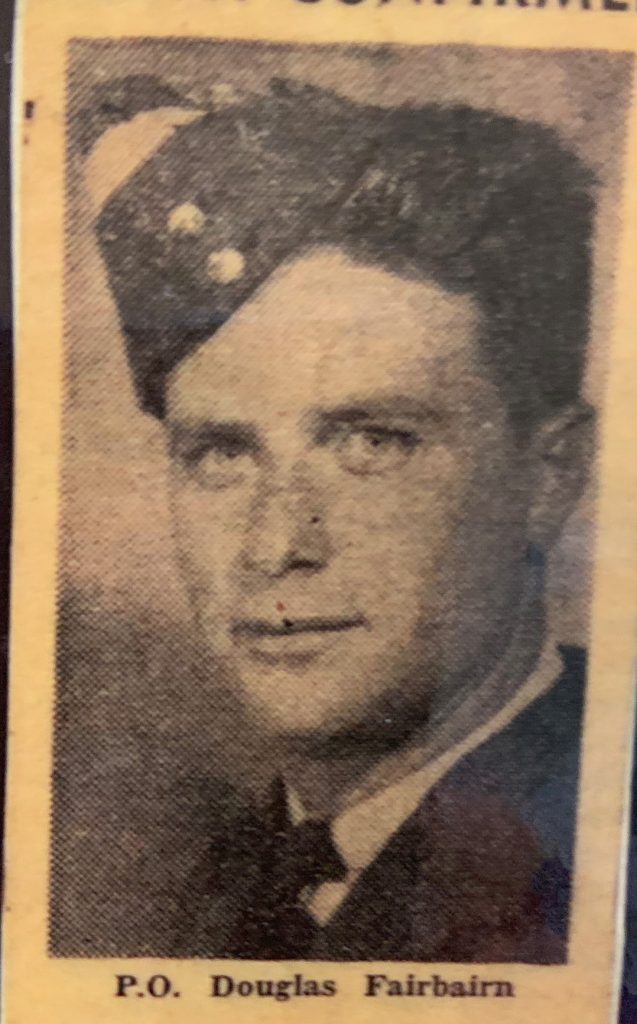
Robert Douglas Fairburn
Postscript:
By Lindsay Elms
Fairburn Lake was adopted 11 November 2003 on map 92F/12 in a cluster of lakes west of Burman Lake. Named by Ruth Masters to remember RCAF Pilot Officer Robert Douglas Fairbairn, J8609, from Comox. PO Fairbairn was serving with 53 Squadron when he was killed in action 24 February 1942 during air operations. With no grave but the sea, his name is inscribed on the Runnymede Memorial, Surrey, UK, panel 100. “Doug was born in Courtenay 22 January 1916. He was educated in Comox where he was a great athlete (basketball, track & golf) and student. He took his senior matriculation at King Edward High School in Vancouver and then became a teacher. He was a teacher and principal at Comox Elementary. He was active in the teacher’s organization, the Comox Community Club and the Courtenay Kinsmen’s Club. He joined the RCAF 12 February 1941. A quote from the local paper at the time said “he was one of the most popular young men to leave the district for the armed forces.” He married Margot Bate of Nanaimo 30 October 1941, received his commission as Pilot Officer 27 November 1941 and embarked for overseas 9 December 1941. He was killed in action on 24 February 1942 when his plane crashed in the North Sea while on a bombing mission.” (information provided September 2003 by niece J. Warnyca, with additional details excerpted from Remembrance Book, Courtenay Museum.) “Mrs. M. Fairbairn…has received news through the Red Cross that her husband’s plane crashed when it hit the masts of a ship they were bombing. Her informant is the one survivor of the crash, who is now in a German prison camp. He was picked up by the Germans from an ice flow. This does not coincide with the report from the squadron leader, in England, who said the bomber had been sent out to bomb Axis craft, off the French coast.” (undated newspaper clipping, Remembrance Book, Courtenay Museum).
Port Alice Remembers Fallen
At the north end of the island west of Port Alice three other mountains and a ridge have been named after young men who lost their lives during the war. Carter Peak is named to remember Canadian Army Private Lawrence Henry Carter, from Port Alice. He served with the Calgary Highlanders, a Canadian Army Primary Reserve infantry regiment, and was killed in action 1 August 1944, at the age of 22. He was buried at Bretteville-Sur-Laize Canadian War Cemetery, in France. It was adopted on 3 April 1959 on 92L/5 map. Mount Clark is named to remember RCAF Warrant Officer 1st class James Anderson Clark from Port Alice. He served as a pilot with 419 Squadron when he was killed 15 September 1942, at the age of 21. He was buried at Cottesmore (St. Nicholas) Churchyard, Rutland, England. Mount Pickering was named to remember Royal Canadian Air Force Flight Sergeant Walter Henry Pickering, originally from Port Alice. He served with 419 Squadron at Cottesmore Aerodrome, UK, an operational training school, when he was killed 15 September 1942, at the age of 26. He is buried at Cottesmore (St. Nicholas) Churchyard, England. Mackay Ridge is named to remember Canadian Army Private James W. McKay, originally from Port Alice who served with the South Saskatchewan Regiment of the Canadian Army Primary Reserve infantry regiment. He was killed in action 3 March 1945, at the age of 28. He is buried at Groesbeek Canadian War Cemetery, Netherlands.
Showery Weather Up-Island
Reported in The Daily Colonist Sunday May 3, 1942, p.4.
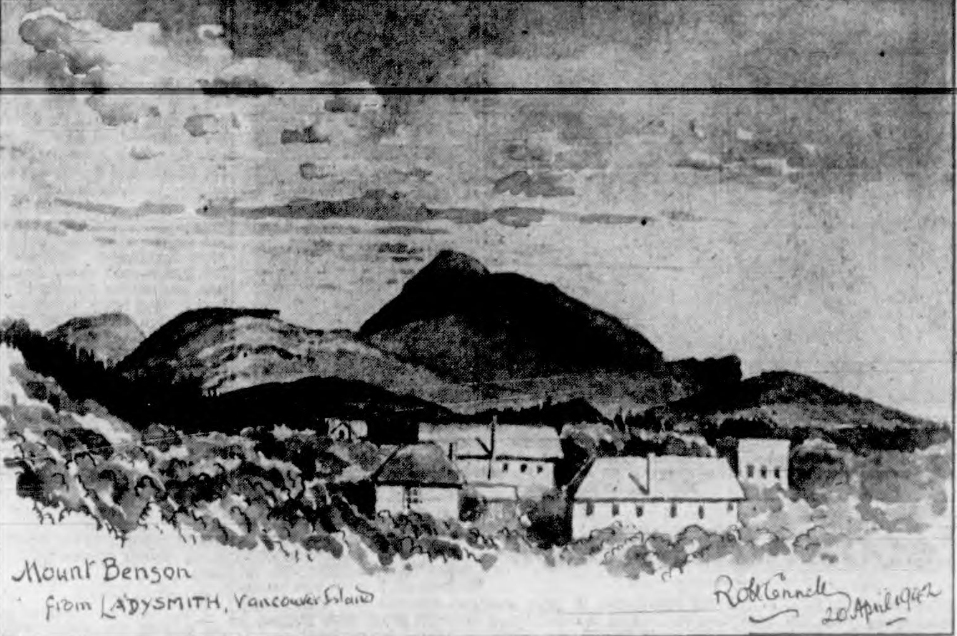
Artisit’s black and white rendering of Mount Benson from Ladysmith, dated 20 April 1942.
Croteau Camp
Reported in The Daily Colonist Sunday May 31, 1942, p.33.

Ad for Croteau Camp.
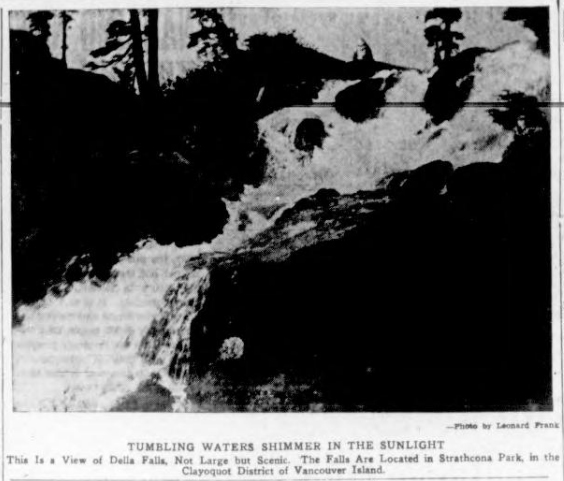
Tumbling Waters Shimmer in the Sunlight, Photo by Leonard Frank.
Forbidden Plateau
Country Of Alpine Meadows Gorgeous Panoramic Views
Reported in The Daily Colonist Sunday July 12, 1942, p.17.
Holiday makers who venture into the great tableland in the centre of the Island long known to the Indians as the Forbidden Plateau will find a veritable wonderland of trails, warm water lakes and alpine meadows. The Plateau lies at the foot of the Island spinal range west of the city of Courtenay and is 147 miles from Victoria, the two cities being connected by the Island Highway. There is nothing tame or tamed about the Forbidden Plateau. It is a rolling tableland broken by hundreds of warm lakes varying in size from one to three or four hundred acres, great stretches of alpine meadows covered with yellow, white and purple heather, crimson-leafed huckleberry, alpine edelweiss, pentstemon, gentians, valerians, phlox, ranunculus and rhododendrons and lightly timbered Indian country. Due to the high elevation and because the soft Summer breezes blowing over the Plateau come in from the Pacific over many miles of fir forest and heather, a visit to this great alpine meadows puts now life and zip into the tired traveler. People especially from the South and inland, feel its effect almost immediately. There is a choice of two trails to the Plateau from Courtenay. The older one, starting at Dove Creek, is about ten miles from Courtenay by road. From here one may either hike or ride the trail which leads uphill and down dale through the forest, rising at one place to an elevation of nearly 6,000 feet, and then dropping again onto the Plateau at Mount Elma at an elevation of 4,000 feet. At the lake at the foot of Mount Elma is Croteau’s Camp, where you will be able to make a comfortable stopover or join a pack train. They have a new yellow cedar log cabin which should interest all travelers. This spot is about one and a half miles from the highest part of the Cruikshank Canyon and some four or five miles from Mount Albert Edward, on which red snow is found. This is a unique phenomenon, red snow, the rich crimson due to form in plant life. The other trail, known as the Mount Becher Trail, goes in from Bevan. Bevan is seven miles from Courtenay. The mountain road from here is nine miles long and rises to an elevation of 2,000 feet. The traveler may walk or ride horseback to the Plateau which is about two miles from here. If one wishes to go to the highest part of the Cruikshank Canyon or Mount Albert Edward, follow the trail from Mount Becher over the Plateau and then on to the canyon, a distance of some ten miles. The Plateau, one hundred square miles in extent with an elevation of over 4,000 feet is bound on the southwest and north by mountains which are snow-covered at all seasons. Some of these rise to over 7,000 feet in height and offer excellent sport for the mountaineer; others can be scaled with comparative ease, while still others can be walked up. From the summit gorgeous panoramic views of snow-crowned mountains, green valleys and blue sea are obtained.

Ad for Croteau Camp, “In the Heart of the Forbidden Plateau.”
Leave For Camp
Reported in The Daily Colonist Thursday July 16, 1942, p.6.
Miss Muriel Aylard and Miss Dorothea Hay have left for Vancouver on their way to Banff and will proceed to the Alpine Club’s camp at Consolation Lake to spend a few weeks.
Buttles Lake
Reported in the Comox Argus Thursday July 23, 1942, p.2.
When Bowser ruled at Victoria and the natural resources of Vancouver Island had been little impaired many tens of thousands of dollars were spent on setting aside a wedge of mountain, forest and lake based on Buttles Lake as a park. About twenty years later another Conservative government spent $300,000 on buying from private owner’s timber berths on Buttles Lake. Unfortunately, they did all of them: eight of them still remain. If these are sold to logging firms, they will not only ruin Strathcona park as a park but will constitute a very grave fire menace to the Island. It may be too late to stop the logging between Upper Campbell Lake and Buttles Lake but the remaining timber limits in Strathcona Park should certainly be acquired by the government before it is again too late. Fortunately, we now have a well-organized nucleus around which public opinion can rally. It is known that the government is well disposed to conservation of beauty spots and would welcome the pressure of public opinion to urge them to action.
Plateau Trail Open to Hikers
Dove Creek Trail Has Been Cleared of Most Log Jams
Reported in the Comox Argus Thursday July 30, 1942, p.1 & 6.
Habitues of the Forbidden Plateau (and there are a number of them who follow its trails every year) will find one route preferable this season. There was such a bad storm about 6 weeks ago at twenty-five hundred to three thousand feet altitude that it cut trees down in swathes on some side-hills. One of these happened to be that along the McKenzie Lake passes and it uprooted 270 trees, some of them of considerable girth. There is not sufficient help available to clear these out so that unless the hiker wishes to do some very strenuous back-packing he had better go in by Dove Creek trail. The Forbidden Plateau Lodge Company decided not to open its camps at McKenzie Lake and Mariwood Lake this year but the Lodge is open and is receiving quite a number of influential visitors, who wish to relax in the lovely surrounding of the Lodge and its excellent service. Here on this flank of Mount Becher, commanding the east coast of Vancouver Island from Nanaimo to Campbell River, there are all the most modern of conveniences, sun porches and wide verandahs with meals supplemented by the excellent garden from which all kinds of fresh vegetables are obtainable. Those who want gentle exercise between the Lodge and Mount Becher can find many saunters commanding beautiful vistas of land and sea scape. The faithful few of the Comox Mountaineering Club, who have back-packed nearly all the furnishings to the cabin on Mount Becher, now have a mountain resting place endowed with all that the real hiker, who is content to do his cooking and back-packing, can desire.
Bucked Trail Through
But if you want to go into the Plateau proper you should go by the Dove Creek Trail. It was at first feared that this trail might be blocked as effectually as that by this side of Mount Becher: but when Mr. Eugene Croteau went in he managed to struggle through with a horse. And ever since then he and his devoted staff have been bucking and cutting their way through the log jams that have been thrown across the trail by the storm so that to-day the trail is little more arduous than last year. But with this exception: there is but one way to get in and that is on your feet. The few horses that are left are needed for packing food. Mr. Croteau has been very fortunate in his staff this year. He has secured a very excellent cook in Mrs. Poitras, who can not only cook but is the soul of the hospitality and Mr. Preston Tait, whose knowledge of the Plateau and its trails is very wide.
A Wonderful Spring
He had the good fortune the other day to find a spring whose ice-cold water will become well known to Plateau lovers as the island on Moat Lake. The hoof of a horse had broken through the soil on the slope of the very steep pitch from Murray meadows to Croteau Lake. He found the water that came from the hole icy cold and pure. He dug it out a bit so that it fills and fills again the tin cup at the side of the trail. Tired and weary from a day’s hike to Mount Albert Edward this spring in the hot of summer is going to be nectar of the gods. It has been tentatively named The Noble Spring after a lady visitor not many years out from old London. But the pearl of Forbidden Plateau is Moat Lake, that gem set at the side of Castle Crag Mountain. It is approached through a sidehill of noble trees carpeted with heather. The only passage to it is over a weathered log over a brawling stream of translucent green water, which falls in lacy folds a thousand feet down to the bottom of the Cruikshank Canyon. Moat Lake is almost as large in Area as Lake Helen McKenzie but its waters are glacier fed and of a wonderful pale green. Not more than two hundred feet above its waters is the lowest patch of snow. Above it towers the black mass of Castle Crag Mountain.
Roman Bath on Island
In Moat Lake is a fairy island of crag and tree and heather. It can only be reached at low water and then by stepping stones. There are a number of pools on it. The largest of these might have been built by the Romans for a bath. It is lipped with red rock and slopes gently down to green water, clear and warm. Like most Plateau pools it is deceptively deep from eight to nine feet at its deep end. No one could desire a more delightful swim than on this island of an artist’s dream. There are trout in Moat Lake—and of prodigious size. But they are very fastidious and not easily to be lured. There are no wind fallen trees in the Plateau proper. Here the trees are so scourged by wind and snow and of so slow a growth during the centuries that those stalwarts surviving cannot be upturned by any storm. No trails there are blocked and if they were it would be easy to go round them as the country is so open.
Fire Near Plateau Lodge
Spectacular Blaze Has Burnt Itself Out
Reported in the Comox Argus Thursday August 20, 1942, p.1.
A very spectacular blaze, which happily do not do much harm, broke out west of the Forbidden Plateau Lodge in Carney, McLauchlin and Larson’s slashing on Thursday night. It seems most probably that it originated with a cigarette butt or a match as it started off the logging road near a water hole. The Courtenay Look-Out man spotted the blaze at once and the logging crew and the Forest Branch got to work at once. The Forest Branch sent up some Mennonites, who are camped down at the Medicine Bowls camp and the company worked to cut fire roads with a “Cat”. The fire ran over the felled and bucked logs but it travelled so fast that it is thought they were not very much damaged. The Forestry officials, seeing that the rest of the logged off area would have to be burnt, set fire to the rest of it and it is pretty well all burnt over now and should be reasonably safe though there will be some smoldering until the rain comes. The blaze provided a gorgeous spectacle of color against the back ground of the Comox Glacier.
Look-Out Man Sees Bush Fires in Panorama
Reported in the Comox Argus Thursday August 20, 1942, p.1 & 8.
By Hope Herd
Elk Falls lookout Station, August15.
On Sunday, the ninth instant, I previewed a most wonderful show. It was an electric storm that took place in the hills away back of beyond in the area that stretches from Mount Alexandra to Buttle lake, across the face of Elkhorn Mountain and into the Valley of the Elk. The tent I occupy faces northwest, so, from the beginning, across the logged off region west of Miller Creek and Quinsam, I was privileged as a one-person audience, to view the grand spectacle. There was, or seemed to be, a peculiarity about this show; there was little thunder, just a low rumbling growl and I felt as though I were witnessing the presentation of a silent movie. I was enjoying supper when the first flash came at about six-thirty. It was on the south side of Elkhorn. The next flash came a few seconds later and struck on the opposite side of the mountain near the entrance to the Elk Valley. The sky southward darkened. There were more electric flashes. The storm spread, so that soon the air was filled with lightning. The prettiest part of the performance was witnessed west of Crown Mountain, where it assumed the proportions of a gigantic pyrotechnic display, then moved on in the direction of Victoria Peak, beyond Garrett. It struck in streaks that stretched blue white from earth almost to the heavens; it flashed in great yellow sheets along the entire length of mountain peaks beyond Upper Campbell Lake, and when the sun went down at nine o’clock behind deckle-edged clouds of smoke haze it gave one an eerie feeling. The storm lasted until long after dark, when the drama ended and the curtain went down on an imposing spectacle.
Four Fires Reported
Friday, August 14, 1942
And now, after four days, I have to report the sighting of three fires on Mount Elkhorn, 24 miles distant, away up near the snow line. One of these is on the east side, the other two on the southeast side of the mountain, and were doubtless started by lightning on Sunday night. Being dampened by rain that usually accompanies electric storms, but having had time to dry out in these close, humid days, the fires have now come to light. One was first noticed about 3:45 on Thursday and the other two spot fires came into view today from Elk Falls Look-Out Station.
And Another One! 5 p.m.
Again, at Mount Elkhorn, near the line that separates it from Kings Peak. This fire is also about 24 or 25 miles distant and is up near the snow line. A deputy ranger has gone in to the scene, took some assistance with him and will get more on the way.
The Fire Is Held
Saturday, August 15, 1942, 8:15 pm
The sun is going down! It shows red through heavy smoke haze caused by fire on the Elk River Timber Company’s workings. Through this haze I can see fleecy filmy clouds and dancing, changing shadows. I wonder if—no, there is no rain in sight for tonight or tomorrow; my two weather vanes, Victoria Peak in the west and Mount Becher in the southeast, tell me that. The wind that has been blowing from the east, north-east and even south-east for a time today is now coming from the north-west, tough omen, and one that means that the fire fighters are up against the stiffest sort of a proposition. It is the same wind that whipped the fire of ’38 into fury and helped the forest fire of that day burn my look-out station on this mountain. The clock runs on. It is now nine p.m.; and as I stand here in the tower, I see what one cannot discern during the earlier hours of the day: that where there is smoke there is fire. Darkness now brings the hungry flames into the picture. I can see them along a stretch of a mile or more, eating their way through what little green timber has been left by the logger in earlier days; here a burning tree falls; there an older growth of underbrush is taken and over and through all can be seen the swirling, boiling, swiftly moving banks of dark brown smoke that makes forest fires appear so fearful. Forest debris that has lain on the ground for years comes to alight and is carried far by the rising wind. There is a long line of red flame that follows the contour of the land; up hill; down dale, in a straight stretch and is shallowed by a heavy gray, dead smoke that shows where a terrific fight has been made by the logging crew who are putting up all they have of energy and stretch to stay the fury of the flames. I remain at my post, for there is a pull to watching a big forest fire, until the destructive monster begins to die here and there.
Sugar Rationing on The Mountain
When sugar rationing went into effect, I was out on the look-out mountain, wild and bare. There is always a way out of a tough spot. I, like others, began to think. If honey is good in a cocktail or hot rum, why would it not be good in hot coffee? Now, I have a neighbor, like myself, a forty-niner. He keeps bees, in fact he has well over one hundred hives. They are his hobby. I know how long Tom Broadland has had the hives. I know how hard he works—in camp and with the bees. So, I decided to try honey in my coffee and it was so good that the sugar refinery has lost a customer. Many others have turned to honey and found it great. We have had a long stretch of fire hazardous days, days that make conditions that are right for the creation of jitters or nervousness in those who watched or who are charged with the destructive, dangerous red menace. Particularly at this time the duty of suppressing outbreaks, the public are asked to be careful with fire, for, under conditions now prevailing anything might happen.
Reconnaissance in Strathcona Park
September 11 – September 17
Reported in The Canadian Alpine Journal Volume 29-No. 1, 1944-1945. p.38-40.
By Ferris Neave
In 1912 the Alpine Club of Canada visited Strathcona Park, climbed Elkhorn Mountain and saluted “the new Alpine fields as yet unconquered, which lay before us.” A generation has passed since Arthur Wheeler wrote this testimonial, but mountaineers have continued to resist the well-hidden attractions of the island ranges. An unbiased appraisal of these mountains, which are of modest height and immoderately hard to reach, may suggest that the neglect has been due as much to common sense as to lack of enterprise. Nevertheless, a brief visit to this region in 1942 served to bring home to W.A. “Alex” McCoubrey and myself the truth of the long-standing assertion that here are peaks of real character, presenting an attractive display of technical problems. On September 11 we drove the rough twenty-one miles from the Island Highway to Upper Campbell Lake and, leaving the car, did an hour’s back-packing on the Buttle Lake trail before the voiceless hospitality of an untenanted shack lured us for the night. The next afternoon saw us at the foot of Buttle Lake, in fine weather marred by the smoke of persistent forest fires. Further progress was deferred while first aid was rendered to a dilapidated rowboat whose seems gaped with fright at the prospect of leaving port. Having reached an uneasy agreement with this craft, we set forth on the morning of the 13th and rowed four or five miles along the bold shoreline of the lake to the mouth of Wolf River. This stream threads a deep valley, winding between the high peaks which stand on the west side of Buttle Lake. We located a faint trail on the north bank of the stream and, taking up our burdens, followed its guidance during the afternoon and throughout the working hours of the next day. The valley is probably typical of the district, that is to say it is heavily defended by thick bush, fallen timber and high bluffs. As a result of time lost in circumventing such obstacles and in bridging intermittent gaps in the line of blazes, the net gain of our labours was less than nine miles. Our final camp was made at a point where the river bends in a sharp elbow under Mt. Conreid. This peak, rising from the valley floor in impressive tiers of yellow cliffs, was an irresistible challenge and next morning (September 15) we made a direct attack on its eastern face. The climbing became steep at no great height above the river, our route following in the main a succession of gullies, clefts and chimneys, which conducted us in about four hours to a high look-out just under the northern (lowest) of the three peaks of Mt. Conreid. Traversing around the west side of this eminence we reached the middle peak, the upper seven hundred feet of which is precipitous on the sides within our view. A vigorous rock climb, which became gymnastic on several pitches, brought us to the spacious and untrodden summit in mid-afternoon. The higher, but less precipitous southern summit of the Conreid series lay beyond our range of action. The one on which we stood, though only just over 5,000 feet in altitude, was 3,800 feet above our camp. It provided a close up view of a country which seemed to bristle with sharp rock peaks, fantastically turreted and bepinnacled. The Golden Hinde and Elkhorn Mountain, both over 7,000 feet, were prominent and impressive but numerous other peaks to the south and west of us claimed almost equal attention. Climbing days are short in mid-September and our evacuation of the summit at 4:15 left insufficient time to retrace the intricate and arduous line of our ascent. We gambled on a shortcut down a big couloir and when it brought us at dusk to the inevitable impasse we accepted defeat and resigned ourselves to a night on the rocky floor of the gully. More than eight hours of the flowing day were expended in retracing our course and descending to camp – a testimonial to the difficulties of travelling on this small mountain. On September 17 we crossed the river and climbed Mt. McBride (ca. 6,700 feet) which stands in the angle between Wolf River and Buttle Lake. We met no noticeable technical difficulties although the vertical interval between camp and summit was considerably greater than is usual in the Rockies and there were of course no guiding marks to show a way through the heavy timber of the lower slopes. Above 5,000 feet the vegetation gave way to a rocky wilderness. Below the summit we crossed a small glacier, devoid of snow and debris and looking like glass which had been melted and poured between the rocks. At the north end of the nearly level summit ridge a towering cairn yielded the record of a survey party who had reached the spot in August, 1937. A quarter of a mile to the south a cairnless eminence rose a few feet higher and we honoured it with a brief visit. The view was much the same as from Conreid but more extensive to the east and north, where Waddington and other high peaks of the Coast range stood out above a drab smoke ceiling. We descended the Wolf River in less than three hours – and then spent an exasperating hour in the dense bush fringing its bank before locating the river crossing and our campsite. We carried home an impression that thirty years had brought little change to Strathcona Park. Its unclimbed peaks still offer rich gifts of graceful line and solid rock to the climber. Its trailless valleys will still test the patience of his soul.
1943
ACCVI on hiatus due to WWII.
Events:
February 19 – Club executive member Allan Baker married Joyce Hopkins in Vancouver.
Section members who attended the ACC general summer camp (Military camp) at Little Yoho: John Gibson, Rusty Westmorland, Rex Gibson, Hewitt Bostock.
Section members who attended the ACC general summer camp at Little Yoho: John Gibson.
No Camps on Plateau This Year
Mr. Eugene Croteau Will Not Climb the Trail In 1943
Reported in the Comox Argus Thursday April 8, 1943, p.4.
Mr. Eugene Croteau will not be climbing the trail to his camp [at Croteau Lake] on the Forbidden Plateau this year. He was the first to establish a camp on the Plateau back in the twenties and he has been acting as host to many travelers since. This year he will stay down in the Comox Valley. There are many reasons. One is that it is difficult to get packers and horses and another that logging operations has cut him off from his camp by the Dove Creek Trail. When logging has finished in the Wolf Lake and Mount Washington area it may be possible to get up much nearer to his camp with a car but that will not be this year. As Mr. Clinton S. Wood has also decided that he cannot have camps on the Plateau, hikers who have made a yearly habit of finding health and healing in the lovely lakes and alpine gardens of the Plateau will have to pack all they want in on their backs this year.
Road Open to Plateau Lodge
Skiers Are now Going Up
Reported in the Comox Argus Thursday April 14, 1943, p.4.
Skiers will rejoice to hear that Mr. and Mrs. Clinton S. Wood are back at the Forbidden Plateau Lodge. The first party of skiers went up the hill above the Lodge on Sunday and many more parties are expected to go. Army and navy men stationed at this district, many from eastern points, where skiing is a ritual, are making inquiries about the chance of getting up. There is still snow at the Lodge but the road has been broken through for cars.
Buttle Lake Timber Is Saved for State
Coalition Government Has Made Terms With logging Company
Reported in the Comox Argus Thursday April 29, 1943, p.1.
Victoria, B.C., April 27
The Buttle Lake timber outside as well as inside Strathcona Park will be preserved for prosperity as a result of an arrangement consummated by order in council today it was announced by Premier John Hart. This timber which was held by the British American Timber Co. Ltd. [BAT] and the cutting rights by the Elk River Timber Co. Ltd. [ERT] will be exchanged for crown timber of equal value elsewhere. It will be recalled that some years ago the provincial government bought the timber rights on Buttle Lake within Strathcona Park. The lake, however, extends outside the park and there was no authority at that time to secure the timber along that part of the lake. Recent amendments to the Forest Act give power to the Lieut. Governor in Council to exchange crown timber for private timber for park purposes. Negotiations were conducted with the companies concerned who generously and wholeheartedly agreed to the deal, Mr. Hart said, “especially the Elk River Timber Co. who simply gave up their cutting rights in the public interest, with no compensation. The British American Timber Co. have cooperated throughout and have been entirely helpful”, the Premier said. The forested shoreline of this most beautiful of Vancouver Island lakes will now be preserved in all its natural beauty, to which access may be made easier after the war. In making the announcement Premier Hart has paid tribute to the work of the Honorable Mr. Gray and the officials of the Forestry Department in this connection.
Skiers Enjoy Easter
Reported in the Comox Argus Thursday April 29, 1943, p.10.
Skiers who found their way up to Mount Becher or the lower slopes of the that mountain had a glorious time. A number of young people broke the way to the Cabin and dug themselves in. There is more snow on the hills this year than for many seasons past. Mr. and Mrs. Clinton S. Wood were busy with visitors at the Forbidden Plateau Lodge. Group Captain S.L. Pope and Mis Gaze came up from Patricia Bay and Mr. and Mrs. Arthur Lowrie of Vancouver and Miss Hedy Lowrie, Mr. O. Lodge and his son Kenneth from Vancouver. Mrs. Joan Impey and her sons Robert and Oliver also of Vancouver. From Naden III came A.B.’s Gourlay, Pike and Ted Leite. The two were first ski instructors at Banff and they prefer the slopes of Mount Becher to those at Banff. Men of the services from the east are delighted to find skiing here and there are likely to be many at the Lodge this year. The road to the Lodge is now free of snow but skiers can come down on the blades to within half a mile. The snow is perfect.
Island Paradise
Reported in The Vancouver Sun Sunday June 14, 1943, p.13.
By Hal Straight
BUTTLE LAKE (Strathcona Park)—via boat, logging train, automobile, bus steamer and postman—Harry Rogers is half of the proprietors on this inland Vancouver Island Paradise. Harry may be 50, he may be 70, he may be 100. He is a silver haired fellow who rests his untroubled head on the full rich bosom of Nature. He is a symbol of this beautiful spot and in him one can find the reason Buttle Lake became aggressive controversy between the government, lobbyists, a logging company and a strong group of Mr. Bigs. Harry worked in the woods for some time for Elk River Timber Co. One day he saw Buttle Lake. Similar to the few before who had seen it and an increasing few since, his mouth dropped open in awe. Shear, timbered mountains dropped straight down to the shores that are lapped by clear, greenish-blue glacier water and flowered with big dogwood blossoms and wild snowballs and soft pastel lake plants. There was Mount McBride above, big and strong but Sunday-clean with its glacial-white bib, other mountains, many sparkling, bubbling streams. Fish in every ripple and game in every glade. Someday that will be for me, Harry Rogers must have said. Someday it was. Now he lives cut off from the wild world, lives in absolute contentment four miles up the beach with two cougar dogs and a fluffy black cat. He hunts for cougars with his dogs, for meat which he cans in the fall, for fish to feed his dogs, and he makes things. And how he makes things!
He Builds His Own Nest
Out of the tall timber around him he has built a lodge which he rents at four dollars per day, a lodge that would serve you nicely in town. He has made many gadgets to fill his time also to make life easier, such as a block and tackle for stringing up deer. He made it out of a piece of wood he cut down. These last two words bring us back to the heated controversy of a few months back. Elk River Timber Co., headed by the personable, good-looking Roger Cobb, had timber claims at the head of this inland paradise. They also had claims along the lake which is 22 miles long, deep in behind Union Bay. Across the lake from Harry Rogers, Mr. William J. Reid had picked up a fishing resort. Mrs. Titus, wife of Philadelphia lawyer, spent $55,000 developing this resort. Inside plumbing. Everything up to date. That somebody went broke and out of a casual fishing conversation in New York, Reid of the Long Beach oil fraternity bought this resort. Reid is one of Mother Nature’s most sporting sons. He is top man in Duck’s Unlimited (American). He is crazy about Buttle Lake. One day he noticed that the shrill whistle of the logging donkey, the rumble of a rolling cold deck, the chug-chugging of the laboring locomotives were getting close to Buttle Lake. Then one day while fishing down where Campbell River unsuccessfully tries to empty the lake he heard the chilling swish, swish of faller’s saws. He sprang into action. He shouted to those who counted that ugly burns were going to be put on Nature’s beauty. Press agents hired to stir up action took liberties as they conducted their word attacks.
Doesn’t Hurt Park
All but about the first five miles of Buttle lake is in Strathcona Park. That doesn’t mean much now. Only ambitious outdoor folk and billy goats can appreciate Strathcona Park. But Reid who knows the accessibility of this paradise by plane because he uses plane foresaw the future value of this park, also the hideous defacement the loggers would make. But the Elk River Timber Co. had cold hard money sunk in a railroad up to that lake so they could reach out and get the timber the world wanted so badly. This there was an argument. Roger Cobb, one would gather, would be no pushover in an argument. But Roger Cobb, born in Maine in the shade beautiful trees, a worker in the Vancouver Island bush since 1915, loves the woods. He loves trees. Like Harry Rogers he, too, loves Buttle Lake. He and his wife spent their short holidays there. Cobb made a deal. He took out the timber up to the end of his steel, which makes a few eye-sore patches at the head of the lake but it doesn’t touch the park and these patches are fairly well hidden. He won’t take up his rights up the lake. He had accepted other timber somewhere else to replace Buttle Lake stuff. It’s hard for a logger to turn away from logging plans made years in advance. Maybe it was hard for Roger Cobb. But somehow, we don’t think it was. We took an hour off from work to sneak a little fishing. Thirty firm, fighting trout, half on the fly and half by me on worm and hardware, all in an hour and fifteen minutes, was our catch. Each fish made Cobb’s eyes sparkle just as the beautiful surroundings of this paradise made him speak softly but with pride when he first entered it.
Harry Has Right Idea
Buttle Lake, then, has been saved for a playground. It is hard to get to now. It won’t be someday and then the government and the loggers will smile proudly and Harry Rogers, if he’s still alive, will still be shooting his cougars and game and still be a symbol of this paradise. If he’s dead, one conversation we had with Harry might signify what Buttle Lake means to worldly folks.
“Do you take a paper Harry?”
“No. So much trash in ‘em.”
“Gotta radio?”
“No. Al Anderson, caretaker, mile and a half across the lakes got one. That’s close enough. They talk a lot of trash.”
“Ever go to town? To Vancouver?”
“Quite often. ‘Bout every ten years.”
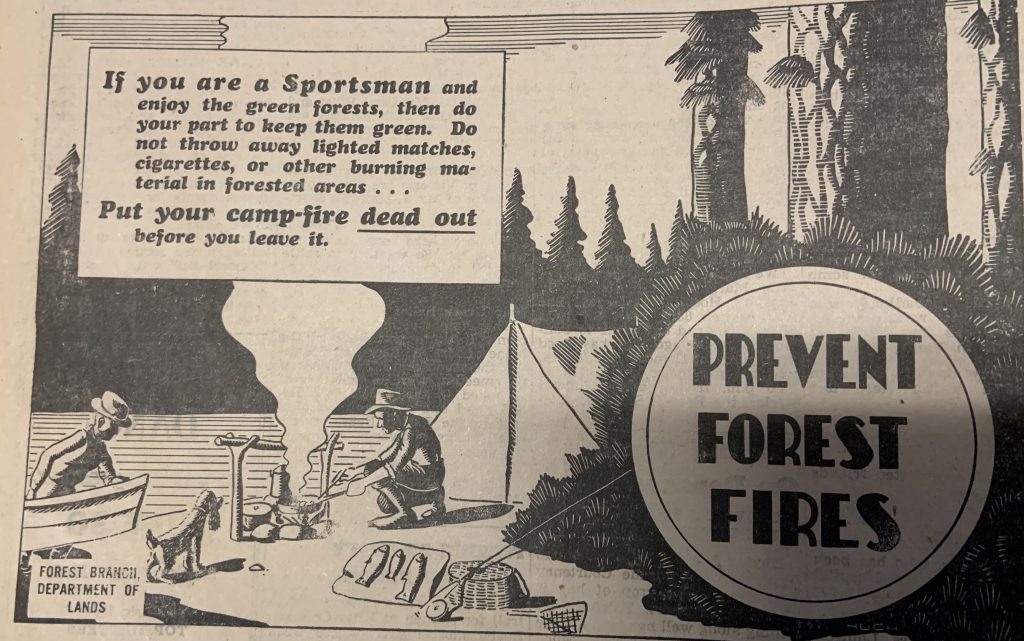
Prevent Forest Fires ad. “Put your camp-fire dead out before you leave it.”
Camp Alicia/Nootka Lodge on Buttle Lake
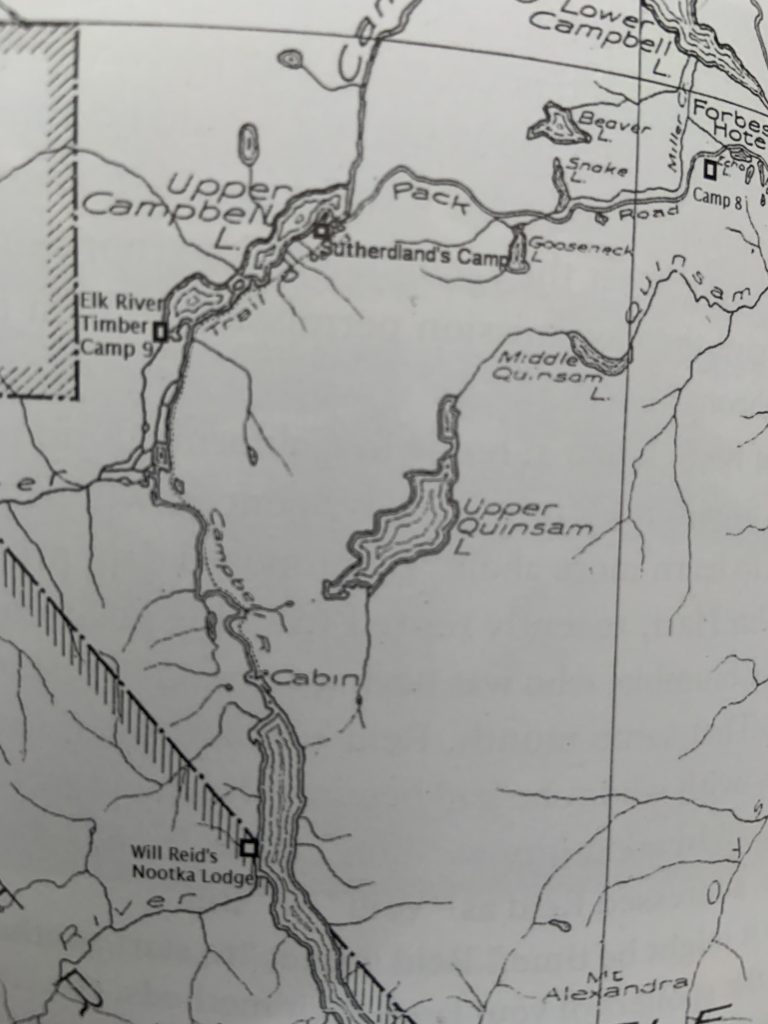
Map showing location of Nootka Lodge on Buttle Lake.
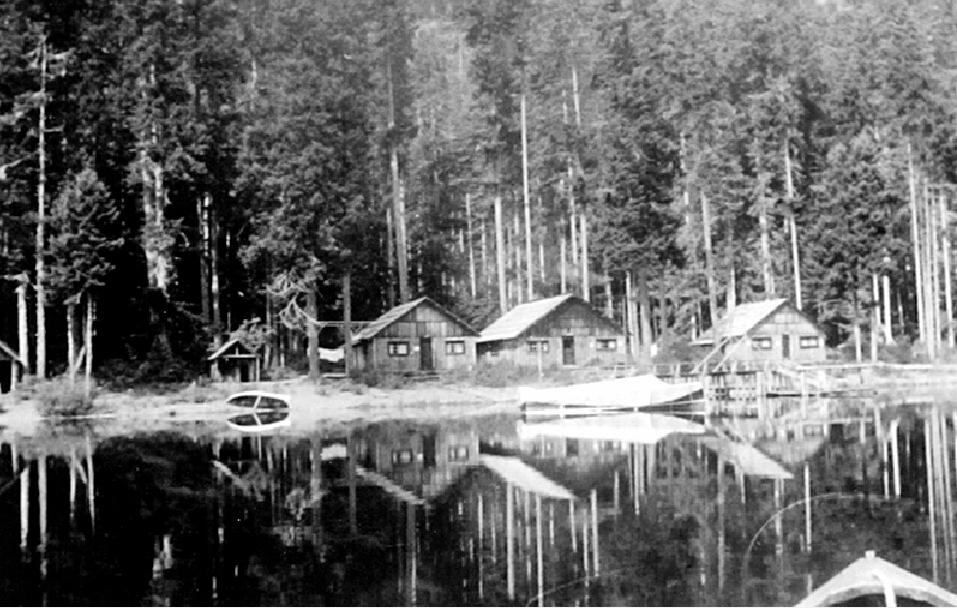
Camp Alice on the west shore of Buttle Lake 1934 – William Reid photo.
In 1929, an American lawyer, Louis Titus purchased a mineral claim on Mount Titus on the west side of Buttle Lake near the mouth of the Wolf River and built several cabins. It became known as Camp Alicia, named for Titus’s wife, Alice. Louis Titus was born on 6 March 1872 in Lodi, California, United States. Son of Lyman and Adelia (Rattan) Titus. He attended the University of California in 1893. He practiced law in San Francisco for eighteen years and in Washington, District of Columbia, fifteen years. He was also the president of the Conservative Oil Corporation. Louis Titus married Alice Jane Rooney, of San Francisco, on 10 October 1911. By 1935 the Titus family engaged Jim Forbes of Forbes Landing to operate their holdings as a holiday camp and Con Reid was hired as a caretaker to live on site in a small cabin called “Con’s cabin.”. In 1935, Titus invited fellow American William J. Reid, the president of Hancock Oil in California, to visit the camp. Titus met Reid in Washington, DC, when they were working there as consultants. Reid, in later life, founded the Will J. Reid Foundation, an independent non-profit foundation based in Long Beach, California a year before he passed away on 8 April 1956. The foundation primarily provides fund to educational institutions, human services, community foundations, as well as to marine research foundations. The assets of the foundation are managed by an executive management team. Reid and his wife Ella, fell in love with the Buttle Lake and in 1936 purchased Camp Alicia. He then began flying up to the camp from his home in California in his Seabee float plane in order to spend summer months there. The site, renamed Nootka Lodge, was improved upon with additional buildings over the years. Aside from the main cabin, there was a cabin for the cook and housekeeper Francis Fisher, and a sauna the family referred to as a Finnish bath. Nootka Lodge soon became a favourite destination for Reid and his family. Harry Rogers, who had a cabin across the lake and was referred to as a “squatter,” likely as he was staying on E. & N. land without permission, became the caretaker after Con Reid (no relation) left. William Reid’s daughter Virginia Reid Moore, took numerous photos over the 18-year period that the Reid family owned the property, and her visual documentation offers a rare glimpse into life on the lake throughout the 1930s, ‘40s and early ‘50s. Reid was an avid fisherman and kept a library that contained Roderick Haig-Brown’s books on fly fishing in which he became acquainted with Haig-Brown’s conservationist leanings. Reid was a determined protector of wildlife and in Alberta, where he had attended university, he purchased several acres of wetlands in order to preserve them for water fowl habitat, and established a Canadian branch of Ducks Unlimited. In 1939, Reid began a correspondence by letter with Haig-Brown. He remarked how much he admired Haig-Brown’s writing and asked for help finding out more about a logging operation he heard was going to commence around the northeast edge of Buttle Lake. Because this section was owned by the Elk River Timber company, it could be worked at any time. Reid was concerned about the visual aftermath of logging right up to the edge of the beautiful park. His correspondence with Haig-Brown went on for over a decade, with the two friends exchanging information on activities around Buttle Lake. Later letters discussed plans by the BC Power Commission to build a dam at the lake. Both were deeply involved in the infamous “Battle for Buttle” and for five years beginning in 1951, fought to convince the commission to move the dam site to the adjacent Upper Campbell Lake. They succeeded, but sadly, Reid missed the opportunity to celebrate when he passed away in 1956. Still, he was spared from witnessing his beloved Nootka Lodge on Buttle Lake shoreline destroyed when old growth forest logged off before the dam was completed. No remnants of the lodge can be seen as it is now below the low water line of Buttle Lake.

Con Reid and William Reid sitting beside Buttle Lake – William Reid photo.
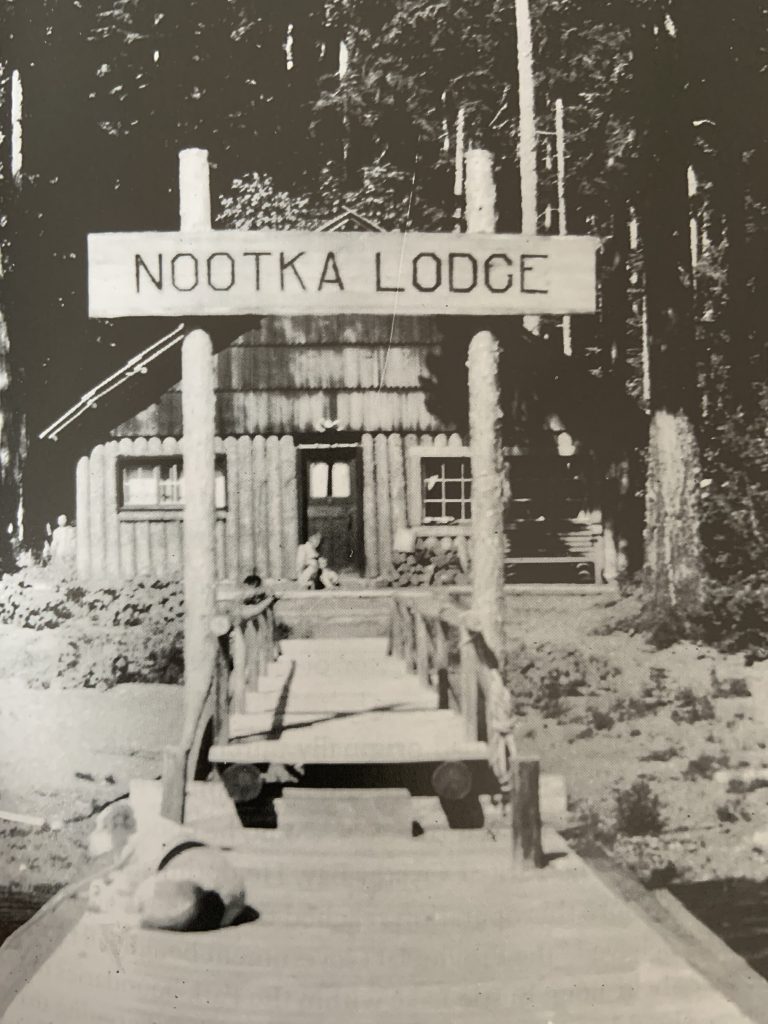
Nootka Lodge on Buttle Lake circa 1936 – William Reid photo.
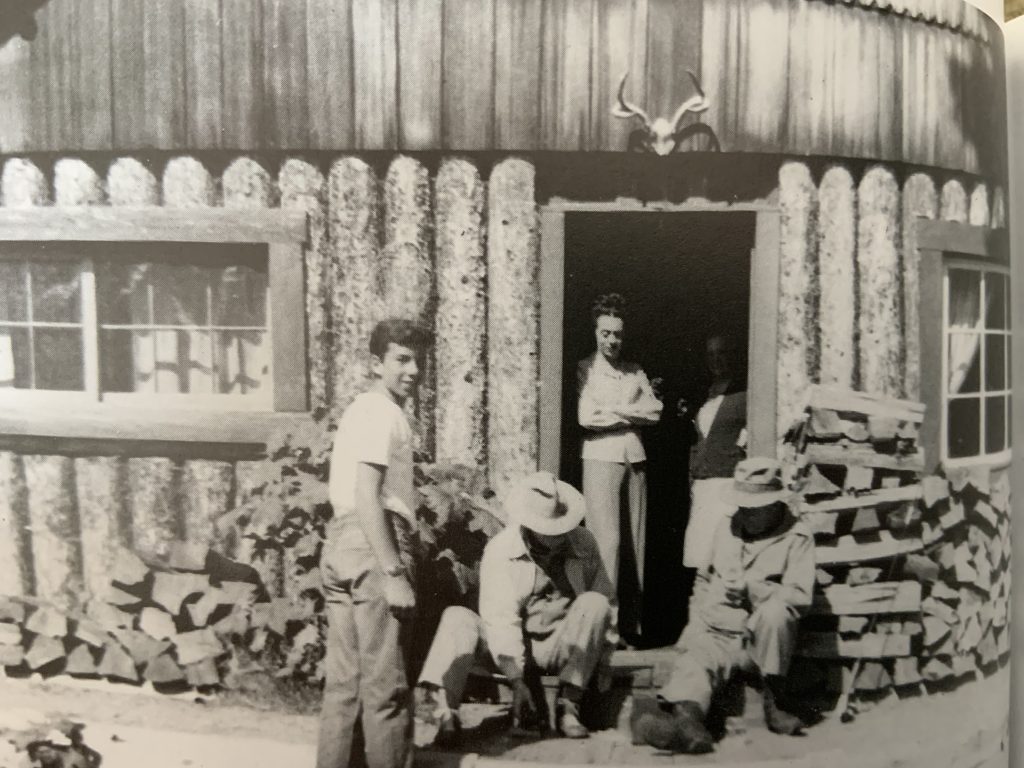
Nootka Lodge on Buttle Lake circa 1936 – William Reid photo.

Will Reid’s Seabee plane on the beach outside Nootka Lodge – William Reid photo.

A float plane on the dock outside Nootka Lodge – William Reid photo.
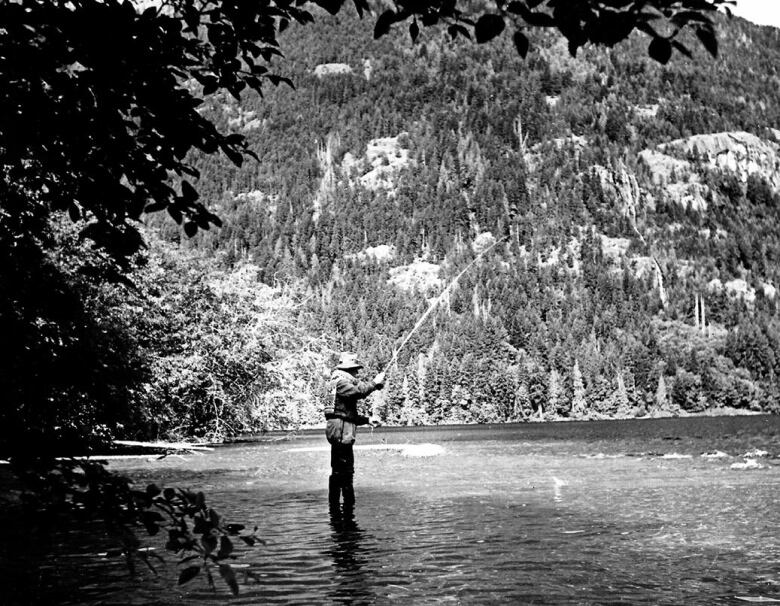
William Reid fly fishing – William Reid photo.

Logging along Buttle Lake 1930s – William Reid photo.
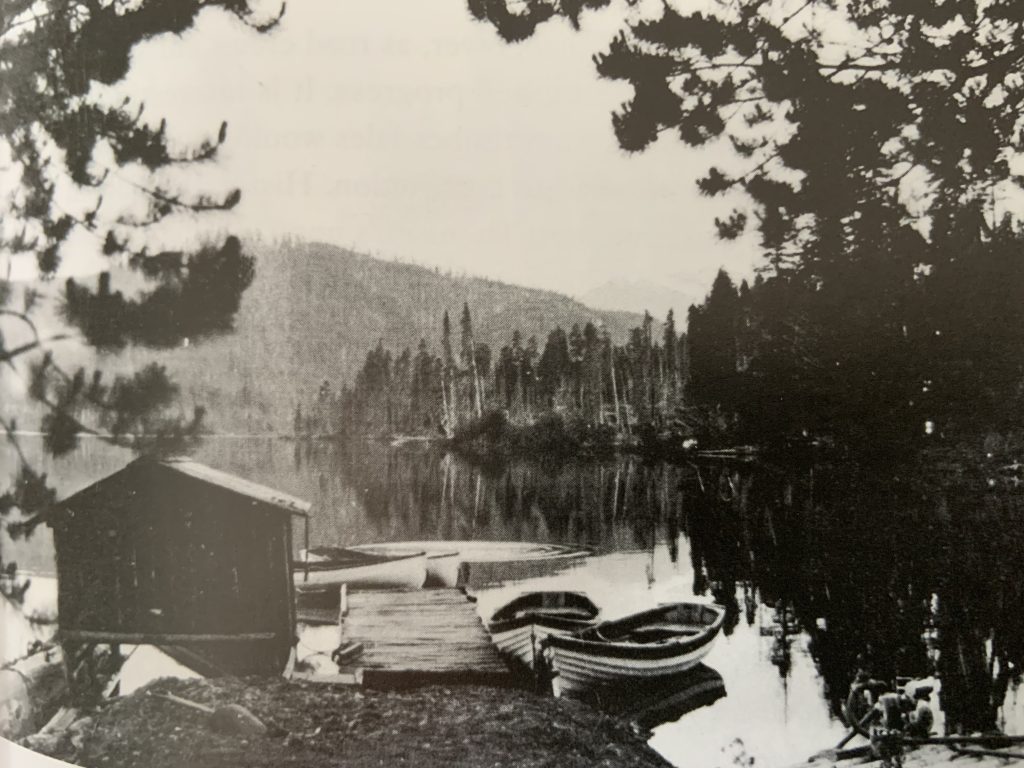
Sutherland’s camp at the lower end of Upper Campbell Lake – William Reid photo.
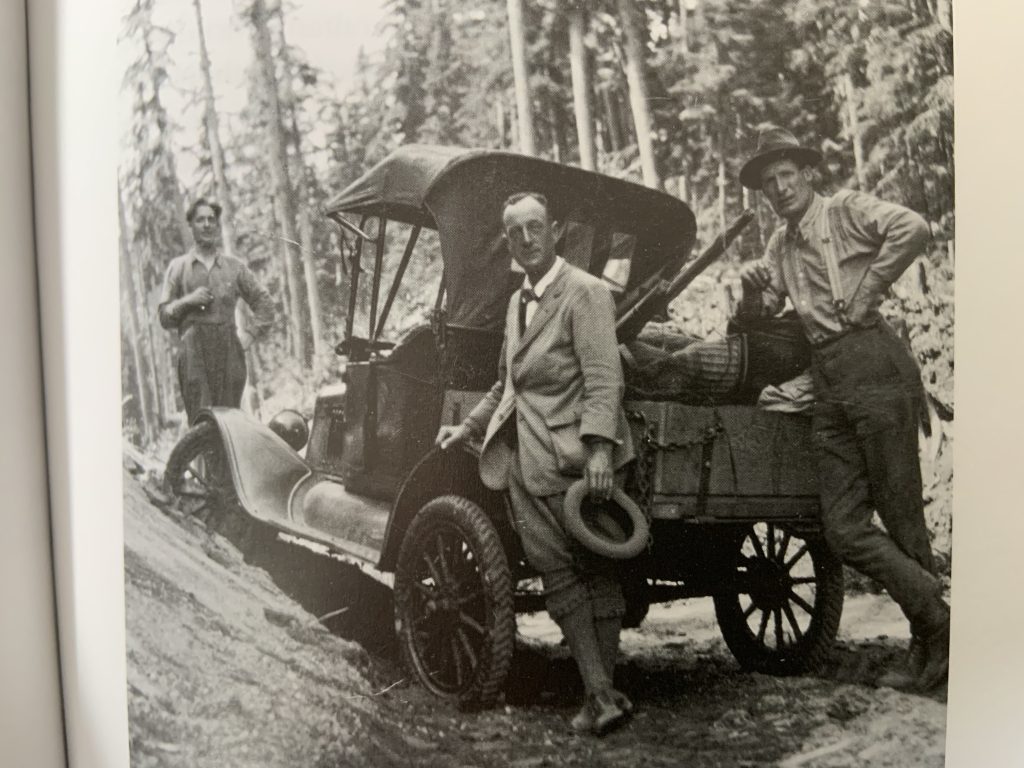
Driving hazards along the logging road to Strathcona Park – William Reid photo.
Thirty Year Old Mystery Is Solved
Bones Found at Little Lakes Tally with Disappearance in 1912
Reported in the Comox Argus Thursday June 17, 1943, p.1.
A woods mystery of thirty years ago has been cleared up by the discovery of a few bones, a knife, and a compass on Comox Creek to the north of the Little Lake at the head of Comox Lake on Monday. Mr. William “Bill” Bell, scaling for the Comox Logging Company about three quarters of a mile north of the end of steel, struck his foot against a thigh bone and began to look around. He found most of the bones of a skeleton except for the top of the skull and one of the feet. Also, he kicked up the rusty remains of a Swedish knife and a compass hung to a chain in a peculiar way. Mr. Bell got in touch with the police and Constable Shepherd went to the head of the lake to investigate. As he went up on the Comox Logging boat Bell spoke of the finding of the bones and Jimmy Wilson of Royston, who was on the same boat, said he was sure that it must be a little English trapper, whose disappearance thirty years ago had never been explained. He was at the Little Lakes in the fall of 1911 or the early party of 1912 when the little Englishman and a Belgian came up to set a trapping line. He helped them build a cabin on the Little Lakes. He noticed then that the Englishman had a Swedish knife and a compass, which tallied exactly with what had been found on Comox Creek. He could not remember the name of the missing man. The man had gone out to tend his trap lines and had never been heard of since. It was also remembered that Harry Rees, who used to roam the woods a good deal in the vicinity of Comox Lake, had in 1927, brought back a boot and a rifle and a revolver he had found near the Little Lake. With these clues Constable Shepherd is satisfied that this thirty-year-old mystery has been solved. But since the name of the missing man has not been discovered yet the inquiry by the Coroner is still continuing. Old-timers are asked to search back in their memories for the name of this man; no doubt they will remember the incident. They would be greatly assisting the police, if they have any information, to call Constable Shepherd at Cumberland or get in touch with the police here.
The President
Above the Yoho valley is a peak called The President (3138m or 10296ft). The President was a popular peak to climb during the Alpine Club of Canada’s general summer camps in the valley because it fell in the category of one of the qualifying peaks for aspiring ACC members to graduate on. To qualify a peak had to be over 10,000 feet. Although it is no longer a membership prerequisite, it still is a popular peak, one which many Vancouver Island section members have gnawed their teeth on. In July 1943, John Gibson attended the two-week Alpine Camp at Little Yoho, but at the end he was one of those asked to stay on for another week to help train soldiers in mountaineering techniques.
The following poem was recorded in the personal diaries of John Gibson, Cobble Hill, 1943.
The Mass Ascent of President
By John Gibson
Oh, long before the dawning of a bright and sunny day
There gathered at the Yoho camp a caravanserai
Of hardened mountain soldiery, all ready for a peak,
Or very nearly ready after training for a week.
After some more arranging they at length got under way;
They started up the Glacier before the break of day.
And plodding slowly upwards, it was their firm intent
To scale the lofty summit of the mighty President.
In single file and side by side tied onto several ropes
They kicked themselves good footholds up steep and moving slopes.
The age’d Peak had never seen such quantities of men
As scrambled on its bosom ‘twixt the hours of six and ten.
They wound across the bergshrund and they scrambled up the scree
And stood upon the summit ere they sheltered in the lee
Of various small boulders while they gobbled up their food,
Which was generally felt to be quite definitely good.
Then they bounded down the glacier, down the snow and down the rock
And were back at their encampment by eleven of the clock,
Demanding further rations from the cooks who’d stayed below,
But the cooks who were not sleeping said quite definitely ‘No’.
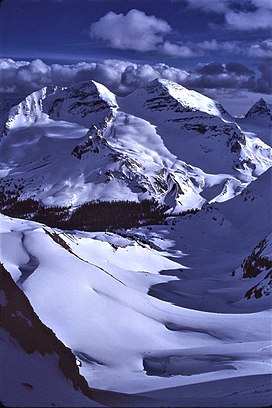
The Vice President and The President.
Alpine Troops
Reported in The Victoria Daily Times Saturday August 28, 1943, p.18.
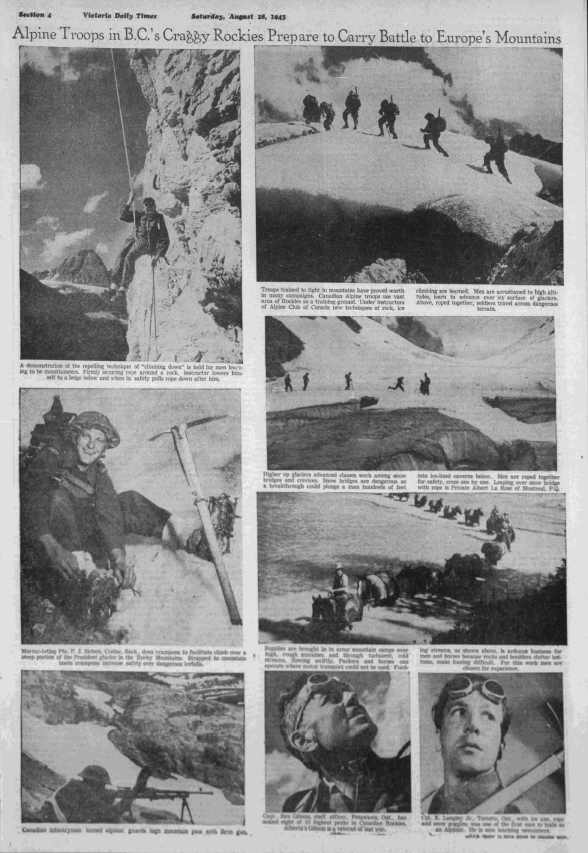
Alpine Troops in B.C.’s Craggy Rockies Prepare to Carry Battle to Europe’s Mountains
Comox Flyer Reported Missing
Pilot Officer Cyril Cottingham Did Not Return From Raid
Reported in the Comox Argus Thursday December 9, 1943. p.1.
Mrs. Cottingham of Anderton Road, Comox, has received word that her son Flying Officer Cyril Morgan Cottingham is reported missing after a raid over Germany. He was the pilot of a Lancaster bomber. Word came through a few days ago by cable from the RCAF Casualties Officer at Ottawa and it has now been confirmed by letter. Flying Officer Cottingham was born in Wales but has lived in Canada for 16 years. He was educated at the elementary and high schools at Comox and was first in his grade when he left high school. He graduated at Uplands air station at Ottawa and had been overseas for a year.

Cyril Morgan Cottingham
Postscript:
By Lindsay Elms
Cottingham Lake was adopted 11November 2002 on map 92F/12 in the upper Red Pillar Creek. Named by Ruth Masters to remember RCAF Flying Officer Cyril Morgan Cottingham, J21625, from Comox; age 25, serving as a pilot with 49 Squadron, and flying his 19th mission when his Lancaster bomber went down during air operations over Germany, on the night of 22-23 November 1943. All crew missing and presumed dead. With no known grave, his name is inscribed on the Runnymede Memorial, Surrey, UK, panel 173. The Cottingham family advises that the wreckage of the plane, with the bodies of the crew still inside, was subsequently located about 20 miles from Berlin. Identification of the aircraft was established from serial numbers on various of the plane’s parts; the crew were possibly buried in unmarked graves nearby. The Comox airport is also named in his honour.
1944
ACCVI on hiatus due to WWII
Vancouver Island member who attended the ACC general summer camp at Paradise Valley: Stephanie Bowes (nee Jones).
Squadron Leader Is Reported Missing
Frank Carter Didn’t Get Back from Sortie on February 16th
Reported in the Comox Argus Thursday February 24, 1944. p.1.
Mr. and Mrs. R.R. Carter have received word that their son, RCAF Squadron Leader Frank Ernest Carter, is missing after a flight over Germany on February 16th. He has been a pilot on bombers over Germany many times and was recently given the rank of Squadron Leader. He was born in Victoria coming here with his parents 24 years ago when he was a month old. He left Courtenay high school after the second year and was on his way to England to enlist in the RAF when war was declared. He stopped at Toronto and for two years worked for his living in the daytime and at night studied to get the necessary educational qualifications for RCAF crew. After he had graduated, he was an instructor in Canada for two years. He went overseas last March and after preliminary training over there got into bomber command. He had taken part in many of the big raids over Germany and has been promoted rapidly. He received his commission just before he left Canada. He married an Ontario girl who lives at Iroquois, and has one child, who was born after he left Canada and whom he has not seen. It was only on Valentines Day that his mother and father got the news he had been made a squadron leader.
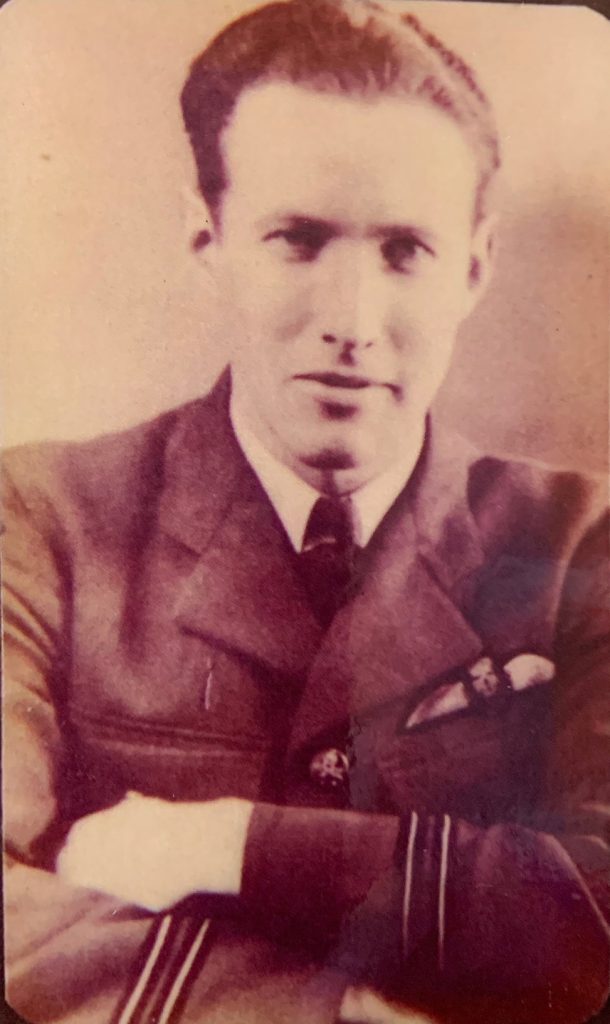
Frank Ernest Carter
Postscript:
By Lindsay Elms
Separated by a narrow neck of land from Schjelderup Lake, Carter Lake was adopted 11 November 1998 on 92F/12. Named by Ruth Masters to remember RCAF Squadron Leader Frank Ernest Carter, of Courtenay, serving with 434 Squadron when his plane was shot down 15 February 1944 over the North Sea. Born in Victoria 17 December 1919; moved with his family to Courtenay as an infant. Carter had been promoted from Flight Lieutenant to Squadron Leader just 2 weeks before his death. He left a widow and one child in Ontario, and his parents in Courtenay. No trace was ever found of Frank Carter, his plane or his crew. He is believed to have crashed in the North Sea after being attacked by a German night fighter as he approached England after a bombing mission. He is commemorated on the Runnymede Memorial at Kent, England, and on Sandwick Cairn in Courtenay.
John Owen
Reported in the Comox Argus Thursday March 30, 1944. p.3.
Mr. and Mrs. P.L. Owen of Little River received word last week that their son WO2 Jack Owen, previously reported missing, was killed in action over Berlin.

John David Owen
Postscript:
By Lindsay Elms
Owen Lake was adopted 11 November 2002 on map 92F/12. Named by Ruth Masters to remember RCAF Warrant Officer 2nd Class John “Jack” David Owen, R138002, from Comox. Owen was serving as a pilot with 625 (RAF) Squadron, and returning from a mission over Berlin when his plane was shot down during the night of 24-25 March 1944. Buried at Tubbergen Roman Catholic Cemetery, Overijssel, Netherlands, grave 3.
“We dodged flak and search lights all the way back from Berlin, and were a way off track, and I thing about an hour late. It was a clear night and I believe I saw the coast of Holland, when the navigator called up the engineer and asked him if we had enough gasoline for an hour’s flying as it would take that long to reach England. The engineer said we were very short and doubted if we would make it. Just then we could hear shells tearing through the kite and as they came from exactly below we presumed it was flak. The plane was full of smoke and Jack opened the bomb doors to drop out anything that might have been stuck up and been on fire. However, everything was gone, and the draft cleared away the smoke. The mid-upper gunner, Harry Nixon of Toronto, suggested that we do evasive action in case it happened again. Jack said ‘okay’ and just started to do so when we were hit again. I could see tracer bullets flying past the nose, so we knew then it was a fighter. The plane immediately went into an almost vertical dive, and Jack shouted to the crew that he couldn’t control the kite, and shouted to the engineer to help him. I couldn’t get the escape hatch open during this time, but between them they managed to pull the plane [out of the dive] for a second or two. I flung open the hatch just as the inter-communication was cut. I could hear nothing over it. The engineer shouted my name, and I saw him reaching for his chute, so I jumped. I went down okay, and landed in a small field just inside the Dutch frontier. I received immediate assistance from the Dutch Underground, and was in Belgium when allied troops occupied the country. Two days after I landed, the Dutch told me they had found the plane (not burned) with five bodies in it; apparently the Germans later found the sixth.” (as told by RCAF P/O F.B. Magee, Salmon Arm; the only survivor)
F.O. Dick Idiens Killed in Action
Bombardier Lost Life Last Friday
Reported in the Comox Argus Thursday April 6, 1944. p.1.
Mr. and Mrs. Joseph Idiens have received word from Ottawa that their eldest son, Flying Officer Richard “Dick” B. Idiens was killed in action last Friday, April 28th. The news has been received with the most profound regrets as “Dick” Idiens was one of the most popular young men in Courtenay. He was in his thirty-fifth year. Dick was born in Toronto, but at an early age, came to Courtenay. He went to Royston elementary school, Courtenay high and St. Michael’s school in Victoria. His first job was at the Gwilt Lumber Company at Bevan but soon joined his father as the Imperial oil agent in the district and two and a half years before he enlisted, he took over the agency from his father. He joined up the day after the war was declared in the RCAF and at the time of his death was a bombardier in a bomber flying over Germany. The funeral took place at Brookwood Military Cemetery, Surrey, England yesterday (Wednesday). Dick was deservedly popular. He was a keen and expert fisherman and mountaineer. For a number of years, he was president of the Comox District Mountaineering Club and was a joyous member of parties held on the snow slopes of Mount Becher and in the cabin of the club under its flank. He did everything with a zest and thoroughness that made it a delight to be with him and work with him.
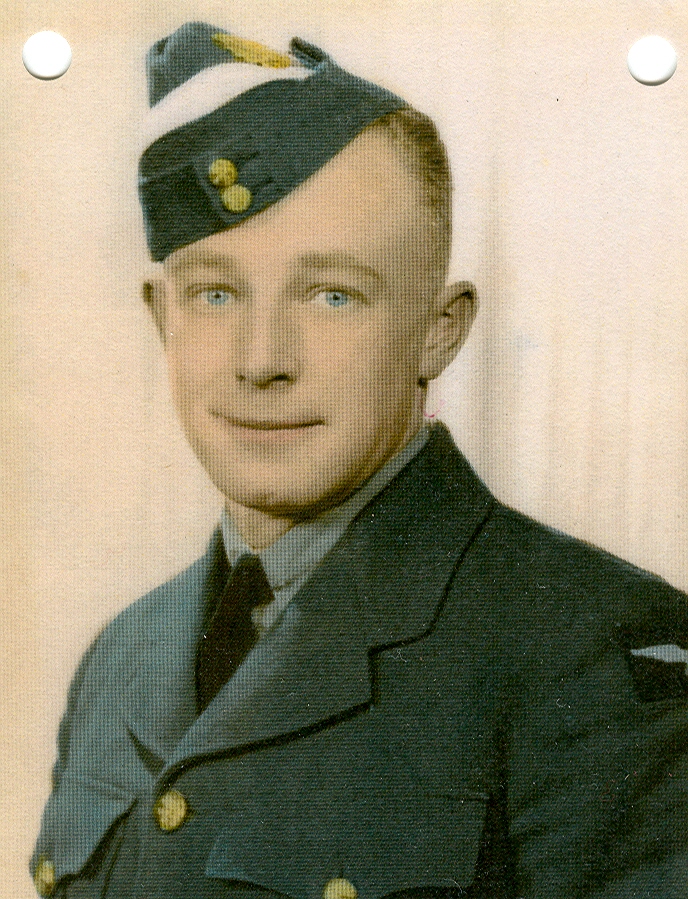
Richard “Dick” Bertram Idiens
Postscript:
By Lindsay Elms
East of the Comox Glacier Idiens Lake was submitted by Ruth Masters, of the Comox District Mountaineering Club in April 1964 to remember RCAF Flying Officer Dick Idiens from Royston. Records were presumably approved shortly thereafter; however, correspondence was missing from BC file so it was re-approved 25 January 1979. Dick Idiens was killed when two Albermarles collided while training for night flying over Oxfordshire, England 28 April 1944. There were no survivors. He was thirty-five. Idiens was born in Toronto 13 January 1910 and moved to Vancouver Island as a young boy. He attended school at Courtenay then Victoria. He was involved with Comox District Mountaineering Club through the 1920’s and ’30s and was one of the first members when it was formed in 1927. He pioneered skiing on Forbidden Plateau and was CDMC president in 1938. He enlisted at Vancouver 29 August 1941; commissioned as Pilot Officer 23 July 1943; embarked for overseas 26 August 1943; promoted to Flying Officer 23 January 1944 and posted to 295 Squadron 9 April 1944. Idiens was buried at Brookwood Military Cemetery, Woking, Surrey.
Minto Airman Is Missing
WO2 Allan Hutton Was Flying Out of Corsica When Last Heard From
Reported in the Comox Argus Thursday April 27, 1944. p.1.
Mr. and Mrs. W. Hutton of Minto received word on Saturday night that their son Allan Hutton, RCAF, is missing on a flight out of Corsica. He is their youngest son and is 26 years of age. He went through the Commonwealth air training school in Canada and has been overseas eighteen months. Eight months ago he was posted to the Mediterranean and has been air gunner on a bomber. He was flying out of Corsica when he was last heard of. He wrote twice a week to his parents most cheerful letters, full of the work he was doing and the fine fellows he was with. He was educated at Minto and the Cumberland High School.
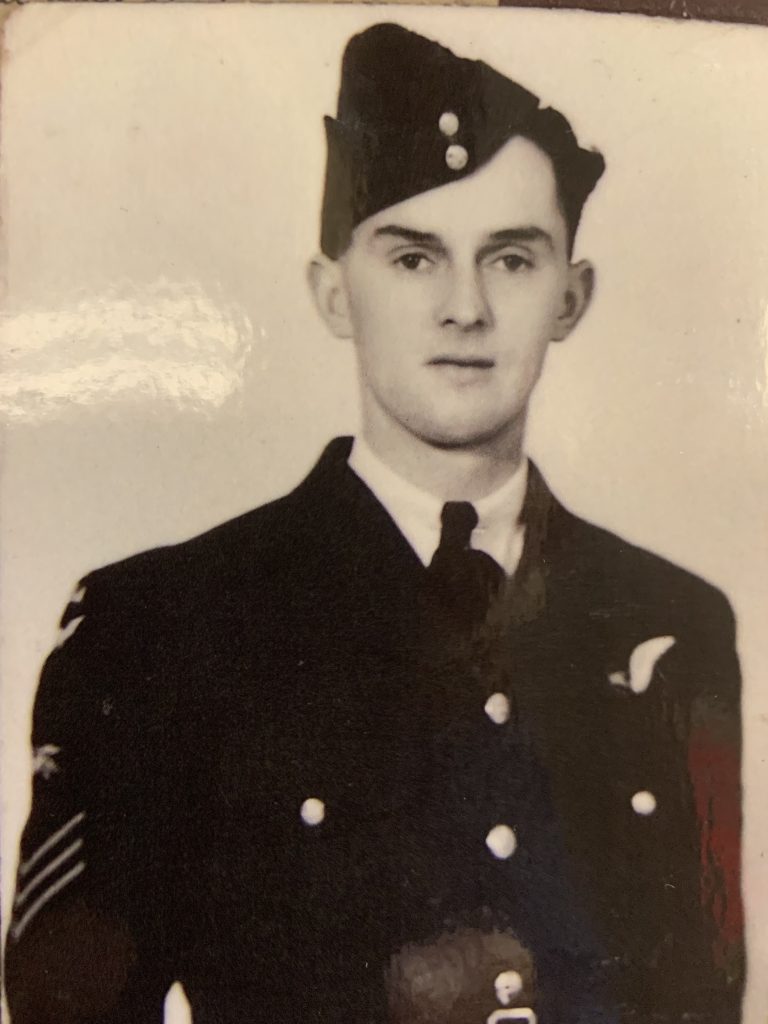
Allan Hutton
Postscript:
By Lindsay Elms
Hutton Lake was adopted 11 November 2002 on map 92F/12 in a cluster of lakes west of Burman Lake. Named submitted by Ruth Masters to remember RCAF Pilot Officer Allan Hutton, J87713, from Comox. Hutton was born at Cumberland 1 September 1919, and worked on the family ranch near Minto before trying his hand as a logger and in a sawmill; enlisted at Vancouver 18 August 1941. P/O Hutton was 26 and serving as an air gunner with 14 (RAF) Squadron on flights out of Corsica, when his bomber failed to return from a mission over southern France, 19 April 1944. With no known grave, his name is inscribed on the Alamein Memorial, Egypt, panel 281.
Mountaineers Elect Officers
Reported in the Comox Argus Thursday September 14, 1944. p.1.
The Comox District Mountaineering Club held its annual meeting on Monday [September 11]. Mr. Bob McPhee was re-elected president, Mr. Sid Williams, vice-president and Griffin Lloyd, secretary-treasurer. Other members of the executive: Messrs. Bert Chandler, Bobby Smith, Roy Macdonald, Miss Peggy Sillence and Captain Harwood Ash. It was decided to have a wood-cutting party for September 24. As soon as possible bunks will be put in the store room at Mount Becher cabin and two new windows.
1945
The next five years: 1945 – 1949.

ACCVI History is a work in progress.